

The Government Property Agency is delivering one of the largest workplace transformation programmes in the UK





FACILITIES MANAGEMENT JOURNAL VOLUME 32 | 04 APRIL 2024 ENERGY MANAGEMENT Updating the BEMS SUSTAINABILITY Insights on Scope 3 40 36 ROUNDTABLE Discussing data-led decisions 28 FM Clinic: Responding to evolution of legislation and regulations a ecting FM
OF POWER
CORRIDORS












AIR PURIFICATION FROM YOUR AIR CONDITIONING FOR ALL TYPES OF AIR CONDITIONING SYSTEMS ELIMINATES VIRUSES, BACTERIA, MOULD & ODOURS Exclusively distributed by Clenzair Ltd in the UK LOW COST. N0 MAINTENANCE. HIGHLY EFFECTIVE SOLUTION FOR INDOOR AIR QUALITY www.clenzair.co.uk info@clenzair.co.uk CONTACT US TODAY TO START YOUR CLEAN AIR JOURNEY

kpm media Unit 1 Mill Place, Platt Business Estate, Maidstone Road, Sevenoaks, Kent TN15 8TB Tel: 01322 662289
Editor Sara Bean sara.bean@kpmmedia.co.uk
Assistant Editor & Social Media Development
Sarah O’Beirne sarah.obeirne@kpmmedia.co.uk Tel: 01322 476815
Director & Designer Warren Knight warren.knight@kpmmedia.co.uk Mob: 0780 1947757
Sales Director Danny Grange danny.grange@kpmmedia.co.uk Mob: 07867 418994
Business Administrator Maxine Howell maxine@kpmmedia.co.uk
Accounts Diane Jarvis accounts@kpmmedia.co.uk
Group CEO Nigel Copp nigel.copp@kpmgroup.co.uk
Editorial steering committee
Alan Hutchinson, Facilities Director, Howard Kennedy LLP
Charles Siddons, Head of Operations, NHS Property Services
Darren Miller, Group Head of Real Estate & Workplace, Experian
Ian Wade, Head of UK Estates, British Medical Association
Lucy Hind, Senior FM Lecturer, Leeds Beckett University
Marie Johnson, Head of Workplace & Wellbeing, Nominet
Paul Cannock, Head of the Estates and Facilities Management Department, European Space Agency
Russell Wood, Senior Facilities Manager at Travers Smith LLP
Russell Burnaby, Head of FM, Regeneration and Environment, Brent Council
Simon Francis, Director of Estates and Facilities, The Institute of Cancer Research
Simone Fenton-Jarvis, Group Director of Workplace Consultancy and Transformation, Vpod Solutions
Wayne Young, Facilities Manager at DB Cargo (UK)
Total Average Net Circulation 12,150 July 2022 to June 2023
SUPPORTED BY


Much of this month’s issue is seemingly devoted to the digital workplace. There is a selection of articles on how technology can provide data-driven insights and automate processes, but it really all boils down to connectedness.
A dictionary definition is “a feeling of belonging to or having a inity with a particular person or group,” in short, partnering, trust, and connectedness.
This was certainly the conclusion of our roundtable (page 28) panel who discussed the benefits of taking a tech-centric approach to managing building operations. It emerged that digital solutions, whether via end user apps or sophisticated building management systems all require a balanced approach between the technology and behavioural changes that successfully connect people with processes.
IFMA’s World Workplace Europe (page 10) took a similar stance, with a series of sessions exploring the evolving relationship between technology and humanity. The key message was to leverage technology responsibly and prioritise people.
To learn how all these concepts can be brought together to connect people and place, read the case study (page 24). This describes how the Government Property Agency (GPA) has invested in a unified and standardised access system that gives Civil Servants the freedom to work from buildings across the government property portfolio.
This approach also enables the property team to build a digital picture of workplace utilisation that will enable them to track behavioural trends, evolve facilities, and improve buildings for the people using them in the future.
Sustainability and energy e iciency were also key topics at the roundtable. We delve deeper into these topics with some insights from the SFMI team on the development of the Scope 3 Framework (page 36) and from page 40 a series of features on energy management; including putting a resilient power infrastructure in place and meeting the Energy Savings Opportunity Scheme (ESOS) deadlines.
© Copyright 2024 kpm media
The
editor may be published in their entirety or in edited form and remain the property of kpm media. While due care is taken to ensure the accuracy of information contained in this magazine, the publishers cannot be held responsible for any errors in editorial articles or advertisements. Subscriptions are available to non-qualifying and overseas readers at £120 p.a. (UK), £160 p.a. (EU countries) and £240 p.a. (overseas-other).
As always, we’d welcome your feedback about any aspect of the magazine, together with your insight into what’s happening in the FM sector.
sara.bean@kpmmedia.co.uk
APRIL 2024 3 FMJ.CO.UK comment this month... FACILITIES MANAGEMENT JOURNAL JOBS Find your next role with the FMJ Jobboard Visit jobs.fmj.co.uk for hundreds of roles in FM and associated industries jobs. fmj.co.uk
kpm media adopts a sustainable policy of using paper from managed forests. Printed in the UK by The Gemini Print Group www.gemini-print.co.uk
publisher does not necessarily agree with the views and opinions expressed by contributors. No material may be reproduced in part or whole without written permission from the editor. Editorial contributions are accepted on an all-rights basis only. Letters to the
EDITORIAL COMMENT

















EXPERT FUEL SYSTEM INSPECTIONS
Protect your most important assets with an annual fuel system inspection (FSI) carried out by our expert engineers.
With a suite of 60 in-depth checks that cover all aspects of your fuel system, an FSI protects your business and local environment against leaks, spills and fuel contamination.
Get in touch today to find out more.
BENEFITS OF AN EXPERT FUEL SYSTEM INSPECTION

Includes a 60-point checklist



Includes visual inspection, fuel testing & more End-to-end service



UK-wide coverage for a range of sectors
Prevent problems before issues manifest
Find out more about our services here:



W: CROWNOILENVIRONMENTAL.CO.UK T: 0330 123 3399 E: SALES@CROWNOILENVIRONMENTAL.CO.UK






06
08
THIS MONTH...
FEATURES
This month’s summary of everything that has hit the headlines in the FM sector.
The latest news and views from membership organisations.
10 Jo Sutherland reports from IFMA’s World Workplace Europe, which explored the theme of creating balance and unity between diverse, dispersed and disrupted relationships.






12

The introduction of a recycling vending machine can contribute to fostering a greener, more sustainable corporate environment, says Emilia Jacobs.
14
While legally, there is no mandated required temperature for an o ice workplace, Jason Webb advises there are legal standards and measures required to provide optimal comfort.
16
James Massey describes the digital tools now available to FMs to enhance e iciency, harness data, monitor buildings, manage energy usage and predict maintenance needs.
18 Richard Sykes, SVP and President, ABM UK and Ireland on navigating the future of FM.
20
Legislative changes impacting the built environment have forced a shi in priorities and duties for those working in facility management. We ask which areas could be particularly impactful for those working in FM?




CASE STUDY

24 Kean Jones, Chief Technology O icer at the Government Property Agency describes the work the team at the GPA have been doing on connectivity across the estate.
ROUNDTABLE
28 FMJ in partnership with Facilio brought together a group of FM thought leaders to discuss the benefits of taking a tech-centric approach to managing building operations.
WELLBEING
32 Gemma Rigby, HR Director at Anabas sees an interconnectedness between employee
health, wellbeing, engagement and, ultimately, organisational performance.
DIGITAL WORKPLACE
34 It’s surprising how many organisations still carry out their commercial processes manually, says Roger Marks who believes it is time FMs adopted a digital approach.
SUSTAINABILITY
36 Chris Havers o ers some valuable insights into the SFMI Scope 3 Framework, which aims to position FM as a key player in driving decarbonisation through the supply chain.
ENERGY MANAGEMENT FOCUS
40 The University of Bristol has benefited from a standardised, open, and robust modern Building Energy Management System (BEMS) for use across its site.
42 Having a resilient power infrastructure in place is now a key component of an energy management strategy says power consultant Richard Henderson.
43 Matt Chadbourn, Energy and Projects Engineer at Synergie Environ o ers advice on preparing for two Energy Savings Opportunity Scheme (ESOS) deadlines this year.



PEOPLE

51 Find out who’s moving where in the facilities management profession.
RECRUITMENT
52 FM is male dominated and needs more widespread female representation. Could better communication help to address this shortfall? asks Emma Thornton of 300 North?
TRAINING
53 Amey’s People Director, Stephanie Johnson describes a ra of recruitment and training strategies that aim to bring back the long term unemployed to the workforce.
CAREERS NEWS
54 A brief roundup of the latest careers news in the facilities management sector.
MIFM
44
New product and service launches and company news from the FM industry.
Next Edition
FM isn’t just about running o ices, so in our latest extraordinary FM case study we report on the huge contribution the EMCOR team are making to the success of the British Sugar manufacturing plant in East Anglia. In the waste and recycling focus, how auditing waste streams not only helps meet environmental targets but can improve the bottom line. Also in May; the British Institute of Cleaning Science (BICSc) and the Cleaning and Support Services Association (CSSA) bring us up-to-date with their Future of Cleaning initiative; with research suggesting the negative impacts of non-compliance on brand reputation, we look at the main challenges for the FM sector in meeting ESG standards; and as climate change leads to greater rainfall and equally drier periods we explain how proactive maintenance plans can help reduce the risks of flooding and grounds damage.
sara.bean@kpmmedia.co.uk
APRIL 2024 5 FMJ.CO.UK
24
FM CAREERS 53
To register for your free copy of FMJ visit fmj.co.uk
COMMENT
COMPLIANCE
FACTS
FAST
BLOG & SOCIAL MEDIA
FM CLINIC
ADVICE AND OPINION NEWS & ANALYSIS 12
NEWS
FMJ
ASSOCIATION
NEWS
EVENT
CONTENTS Follow us on Facebook and Twitter @FMJtoday
LEGAL VIEW


NEW EMPLOYMENT RIGHTS REGULATIONS: BEYOND HOLIDAY PAY REFORM
David McCormack, CEO, HIVE360
The Employment Rights Regulations 2023 bring changes to rules for irregular hours and part-year workers, and more straightforward rules for employers. Their impact on Holiday Pay has been grabbing the headlines, but there’s much more to them than this, as David McCormack, CEO of employment solutions expert HIVE360, explains.
“The new Regulations aim to create more straightforward rules for employers managing irregular and part-year workers by removing confusion and preventing over and under payments in comparison to full time or fixed hour workers.
The changes follow the 2019 Supreme Court ruling Harpur Trust v Brazel, which meant that part-year workers on permanent contracts were entitled to the full 5.6 weeks’ holiday pay that a full-time worker would receive.
Changes to how holiday pay is calculated have grabbed headlines, but there are other regulations also affected.
What are the changes?
The new Regulations:
• Define categories of ‘irregular hours’ and ‘part-year’ workers in relation to the new accrual method and rolled up pay.
• Allow holiday to accrue based on hours worked, capped at 5.6 weeks.
• Base holiday pay on an hourly rate calculated from average weekly pay.
• Allow leave to be carried forward in certain circumstances, as detailed in the Government guidance.
• End the provision of leave being carried over due to COVID.
• Introduce details around calculating accrual in respect of maternity, family related leave and sickness.
• Allow holiday pay to be ‘rolled up’ and paid in regular pay periods.
Whilst these took effect on 1 January 2024, the most significant changes only apply to annual leave years beginning on or after 1 April 2024.
Holiday Pay Reforms
Rolled up holiday pay has been a big talking point, but the devil is in the detail.
• Irregular hours and part-year workers have holiday pay calculated as 12.07 per cent of actual hours worked in a pay period, for leave years starting on or after 1 April 2024. This is based on all workers being legally entitled to 5.6 weeks’ leave; the guidance states they may be entitled to more than the minimum if specified in their contract.
• It is not obligatory; employers can choose not to implement. If they do, employers must take steps including contract changes, making it very clear if a worker falls into the irregular hours/part-year worker category, and, effectively monitoring the worker is taking the required time off.
Considerations
The changes mean an irregular or part-year worker could potentially carry over up to 28 days leave as a result of being off sick, so it’s crucial employers familiarise themselves with the detail and that workers are made aware of their rights.
The new accrual rules apply to several areas, so a one size fits all approach just will not work.
There should be benefits for any irregular hour and part-year workers who engage with agencies or umbrella companies. Rolled up pay means payslips will itemise hourly rates and holiday pay included, and limit the questionable providers that have relied on unclaimed ‘holiday pots’ at the end of the year, instead of it reaching the workers.”
WAVE OF SUSTAINABILITY STRESS AND LEGISLATION LETHARGY HITS UK FIRMS
A new survey from Mitie has found that UK organisations are feeling overwhelmed by the strain of sustainability reporting, with legislation lethargy on the rise as they tackle the labyrinth of new and existing reporting legislation. This comes alongside an increase in the number of ESG reporting mandates and the expectation of total transparency around net zero targets from policymakers, investors and customers in the UK and Europe.
The survey found that more than half (55 per cent) of UK sustainability decision makers think that current sustainability reporting requirements are too complex. Almost half (46 per cent) are reporting to three or more di erent ESG frameworks and this figure rises to as many as eight frameworks for those in heavily regulated sectors like professional services, financial services, healthcare, and technology.

Government standards like the Carbon Reduction Plan (CRP) and Energy Saving Opportunity Scheme (ESOS) were identified as the frameworks most reported to. Emerging standards established outside of the UK closely followed, with almost a fi h (17 per cent) saying they planned to report to both the recently introduced International Sustainability Standards Board (ISSB) and the EU’s Corporate Sustainability Due Diligence Directive.
Despite the complexities associated with reporting, almost two fi hs (34 per cent) still acknowledged that compliance with new ESG regulation has positively influenced their sustainability strategy.
WORKFORCE HEALTH, SAFETY AND WELLBEING SHOULD BE AT THE HEART OF ECONOMIC GROWTH, SAYS BRITISH SAFETY COUNCIL
Ahead of a UK General Election expected this year, British Safety Council has published a manifesto containing policies to support better productivity and growth as well as ensure a healthier, safer and happier workforce.
The UK lost an estimated 32.5 million days to work-related ill-health and nonfatal workplace injuries in 2022/2023, and sickness and illness are at a 10-year high, costing businesses and the economy up to £77.5 billion a year. Poor mental health is also estimated to cost UK taxpayers around £45 billion each year.
Fi y years on from the landmark Health and Safety at Work Act (1974), British Safety Council, is calling on all political parties and representatives to “commit to making the next 50 years the safest in our nation’s history”. Its ‘Manifesto on Health, Safety and Wellbeing’ sets out seven key calls across four policy areas: regulation; wellbeing; technology and the future of work; and skills.
British Safety Council’s calls on a future UK Government include:
• A dedicated Ministerial portfolio responsible for wellbeing, which would also be given cross-governmental responsibility for the development and implementation of a National Wellbeing Strategy.
• Support for companies that invest in new and developing technologies (including AR, VR, and AI) for the purposes of improving health, safety and wellbeing standards in the workplace, enabling them to o set up to five per cent annual investment.
• Health, safety and wellbeing training required by law included in a new ‘Skills Tax Credit’ when reforms are made to skills-based education.
• Adequate funding for the Health and Safety Executive (including the Building Safety Regulator) and for local authorities who hold statutory duties for the regulation and inspection of health and safety.
To read the British Safety Council’s 2024 Manifesto visit: https://bit.ly/43xMXeF
APRIL 2024 6
NEWS & ANALYSIS FMJ.CO.UK

Ian Mitchell
Co-Founder of Bartlett Mitchell has passed away
Ian Mitchell, who cofounded Bartlett Mitchell (now known as BM Caterers) with Wendy Bartlett back in 2000 has passed away at the age of 74.
In a statement, Bartlett said: “It is with great sadness that we announce the passing of Ian Mitchell, co-founder of BM, a great friend, and one of the industry’s true greats.
“Ian was a caterer through and through, with a genuine passion for people, service, and food. He always held the highest standards, and everything that BM is today stems from the most generous, jolly, and loveliest gentleman you would ever be likely to meet. Ian’s love for life and his unwavering pride in our #bmfamily were evident in every interaction we shared.
“He was a beacon of positivity and generosity, always quick with a smile and an encouraging word. I can imagine him urging us to raise a glass in his honour. Reflecting on our journey together spanning more than 35 years, I am filled with gratitude for the privilege of calling Ian not just a business partner but also my dearest friend.
“The memories we created and the support we offered each other are treasures I will cherish forever. We will miss him dearly, as will so many people from across our industry. While we mourn Ian’s loss, let us also celebrate Ian’s remarkable life. His memory will continue to inspire us, guiding our actions as we carry forward his legacy at BM.”








Retrofitting non-domestic property will play a crucial role in achieving net zero targets. Building on the UK Green Building Council’s (UKGBC) Retrofitting O ices report, the UKGBC’s NonDomestic Retrofit: Retail and Logistics project seeks to explore how we can best decarbonise the retail and logistics sectors through e ective retrofit planning and delivery.
According to UKGBC’s Whole Life Carbon Roadmap, the non-domestic building stock is responsible for 23 per cent of the UK built environment’s operational emissions, with the retail and logistics sectors being the primary drivers of operational emissions. With around 80 per cent of the buildings that will exist in 2050 already built, UKGBC says we need to deliver rapid improvements in the delivery of the energy e iciency of our current building stock if we are to achieve our net zero ambitions.
This is why UKGBC has been delivering a workstream covering the retrofit of these energy intensive non-domestic buildings. This next phase will focus on buildings in the retail and logistics sectors and aims to explore the operational energy performance improvements that can be achieved, alongside the consequent cost and embodied carbon impacts. This is intended to inform planned upgrades to existing assets and help overcome common challenges and to meet the likely ambition behind emerging net zero carbon performance limits, such as those being developed by the UK Net Zero Carbon Buildings Standard. In addition, the report will collate real-world examples of retrofit measures to illustrate what these projects can look like and the lessons learned from implementation.
Six organisations from across the built environment sector have come together to support UKGBC’s project and make this much needed analysis possible. These organisations are: AtkinsRéalis, Federated Hermes, Integrated Environmental Solutions (IES), Mitsubishi Electric, Ridge and Partners, and SEGRO.
Formed of experts in retrofitting retail & logistics buildings from across UKGBC’s Advancing Net Zero programme partners, project partners and wider UKGBC membership, the task group will work closely with the UKGBC team to undertake this research over the next year.
APRIL 2024 Property Connect Golf Day Farleigh Golf Club, Warlingham, Surrey www.property-connect.org
APRIL 2024 MSP Show ExCeL London www.servicedeskshow.com
MAY 2024 Net Zero Lighting Conference 15Hatfields Conference Centre, London www.thelia.org.uk
17
17-18
02
2024 UK Construction Week London ExCeL London www.ukconstructionweek.com
MAY 2024 FOOTPRINT+ Old Billingsgate, London www.footprintplus.com
MAY 2024 Interclean Amsterdam RAI Amsterdam, The Netherlands www.intercleanshow.com/amsterdam
MAY 2024 Assist FM Conference Crowne Plaza, Glasgow www.assistfmconference.co.uk
MAY 2024 UKREiiF Leeds City Centre – Royal Armouries www.ukreiif.com
JUNE 2024 InstallerSHOW NEC Birmingham www.installershow.com 11-12 SEPTEMBER 2024 Environmental Services & Solutions NEC Birmingham www.ess-expo.co.uk DATES FOR THE FM DIARY APRIL 2024 7 ORGANISATIONS AND EXPERTS JOIN UKGBC TO BETTER UNDERSTAND OPPORTUNITIES TO RETROFIT NON-DOMESTIC BUILDINGS
07-09 MAY
08-09
14-17
16-17
21-23
25-27
FMJ.CO.UK NEWS & ANALYSIS
COMMITTING TO BOOST EDI ACROSS THE SECTOR



The future of work.
widespread benefits.
Digital innovation.
Sustainability. IWFM is no stranger to tackling today’s biggest issues to educate, inform and advance the workplace and facilities management (WFM) sector.
IWFM, publicly committed to equity, diversity and inclusion (EDI) in 2021 and believes a diverse and inclusive WFM sector can boost this lynchpin profession’s agency in organisational success. But how to make the greatest impact?
In 2023, we took part in a research journey with 11 other professional membership and regulatory bodies, representing approximately 750,000 UK workers. The Young Foundation was commissioned to better grasp the role of such bodies in driving EDI.
The result, Beyond Buzzwords, was published recently, underlining the economic and social benefits that EDI can bring, while noting substantial barriers to progress. The report confirmed the critical role that professional bodies like IWFM can play in bringing about the ‘systematic’ change needed to reap these
WORLD FM DAY 2024 TAKES PLACE ON 8TH OF MAY 2024
Despite the economic and social opportunity from EDI, the WFM specific findings were stark. The report and the sector case study detailed the consequences for this community of not acting –aggravating an already chronic skills crisis. Notably, it was found that WFM professionals experience more severe discrimination and exclusion. More facilities managers change jobs, take career breaks, experience mental health issues and turn down professional opportunities. They are more likely to leave WFM because of their experiences.
To embed positive change and drive progress in the future, IWFM has committed to adopt - or build on - all the Young Foundation recommendations for professional bodies. We’ve released an updated EDI Public Statement, which seeks to:
Put EDI at the heart of professional life through updated codes of ethics/conduct, reviewing professional standards and reframing EDI as non-negotiable.
Foreground EDI in upskilling and reskilling, including the accreditation based on core competencies around EDI.
Create opportunities for professionals to shape EDI in their organisation, such as forming
working groups and building accountability though feedback and communication. Ensure all strategies, policies, procedures and practices are approached with an EDI lens, continuously monitoring progress.
A high-level action plan has been informed by our EDI Focus Group and approved by our Board, who will review progress on a regular basis. IWFM will continue to engage with our membership to communicate the progress it has made in this area. Additionally, IWFM will be hosting a webinar in which we outline the report, discuss our rationale and explain how our current actions will better shape our organisation, sector and community.
EDI is essential in WFM for promoting a sense of community belonging, cultivating professionals’ talents, driving organisational success and demonstrating how our profession is a career of choice in today’s economy. We look forward to engaging with our community, profession and other stakeholders as we recommit to EDI. It is crucial for IWFM to prioritise these values – and for organisations across the board too.
SECOND IFMA REPORT ON WOMEN IN FM HIGHLIGHTS CONTINUING UNDERREPRESENTATION



We celebrate World FM Day (WFMD) on 8 May 2024 and encourage all of our colleagues, client organizations, and suppliers/vendors associated with the FM industry to recognize the critical work that FM Professionals contribute to the Built Environment.
WFMD is the opportunity to recognise the behindthe-scenes heroes that keep our workplace safe and productive, while providing for a healthy environment.
We also acknowledge the opportunities that FM provides for careers and ongoing professional FM Development. Please join Global FM to inspire, integrate and innovate. For more information visit https://globalfm.org/world-fm-day

IFMA’s recent publication of a white paper on factors impacting retention and advancement of women in facility management brings to light the underrepresentation of women in senior FM roles and emphasizes the need to address the high turnover rate among women in the industry. By uncovering the barriers women face in FM, the report aims to assist in the recruitment and retention of women through targeted strategies such as mentorship.

Amid rising demand for skilled professionals, empowering women to excel and advance in facility management is vital to the growth and sustainability of both the industry and organizations worldwide. Diversifying the FM workforce brings fresh perspectives to the workplace, which fosters innovation and financial success.
“Our industry is being revitalized by a more diverse and inclusive workforce, adding unique viewpoints and new approaches to corporate culture, health and safety, smart and responsible workplaces, and meaningful and rewarding work,” said IFMA President and CEO Don Gilpin.


Last year’s ‘Women in FM: A Global Salary and Compensation Supplementary Report’ was the most comprehensive and detailed analysis on the state of women in facility management. It was the first report of its kind for the FM industry, finding that women seeking employment are obtaining FM jobs much faster than men at every job level.
APRIL 2024 8 ASSOCIATION NEWS
IWFM CEO, Linda Hausmanis
NEWS & ANALYSIS FMJ.CO.UK
John Carrillo CFM, IFMA Fellow and Chairman of Global FM
Comply with the rules by using the people who helped make them.

Entrust Colt with your smoke control servicing.
Colt’s technical directors have long been involved in the development of fire and smoke control standards and guidance. Our team of expert engineers receive regular training from these same technical directors so you can rest assured that they know exactly how to keep your buildings safe.
Competency is crucial.
When it comes to smoke control maintenance, you must ensure your service provider is highly competent and certified by a third party. Colt is the UK’s first company to be certified to both IFC SDI 19 and SDI 05 schemes, awarded in recognition of our skill as an installer and servicer of smoke control systems and fire curtains.
Each one of our expertly trained engineers has one aim in mind – to keep your buildings safe and legal, whether your system was designed and installed by Colt or not.
CERTIFICATED INSTALLER OF ACTIVE FIRE PROTECTION
Certificatenumber:IFCC3141

Smoke is different to fire.
Smoke is different to fire and needs specialist maintenance. All too often, smoke control maintenance is lumped in with fire alarms and security and has only a functionality test or is subcontracted out to ‘smoke vent’ or ‘AOV’ operatives. Unlike Colt, unfortunately (and dangerously), not all these companies are fully accredited or certified to be doing maintenance on systems as complex as smoke control.
To find out more, visit us at: coltinfo.co.uk/service-maintenance calls us on 02392 491735 or email service@uk.coltgroup.com
Choose Colt




Service Expertise built on experience.
IFMA WORLD WORKPLACE EUROPE
A FINE BALANCE
IFMA’s
World Workplace Europe explored the theme of creating balance and unity between diverse, dispersed, and increasingly disrupted relationships. Jo Sutherland, MD, Magenta Associates reports

In the bustling atmosphere of Schiecentrale, a former power plant and national monument in Rotterdam, discussions explored the evolving relationship between technology and humanity. From Geertrui Mieke De Ketelaere's insights into the ethical considerations of AI applications to Mark T. Hofmann's examination of the psychology behind cybercrime, delegates gained a deeper understanding of the delicate balance required to harness the benefits of tech while mitigating the potential risks.
The event delved into AI's evolving role in the workplace and workforce, including its potential to relieve employees of repetitive and mundane tasks, while raising moral dilemmas in using AI, which is inherently biased, to support decision-making. Despite AI's capabilities, it lacks common sense and struggles with abstraction. And there’s no fix for that, so there will always be room for humans. Phew.
But there are other, much bigger question marks to consider around
fair use. While ChatGPT version 4 can analyse the contents of one’s fridge to suggest recipes, other forms of generative AI have been known to quarrel about the origin of French fries. As it stands, AI lacks a universal language and is steered by biases. Not so long ago, one could ask the platform how to bomb Iraq, said De Ketelaere. The platform would oblige, giving the researcher a to-do list to support their quest. Ask it how to do the same in Ukraine, and the platform issues a warning, saying that is not a moral or appropriate question to ask.
Ethical considerations aside, technical challenges, such as the crazy volume of CO2 emissions, were also addressed. For every question asked of AI, for example, whether that’s a ‘Hey Google’ or ‘Alexa’ command, 11-13 grams of CO2 is emitted. 10ml of water is required to cool down the servers every time someone asks ChatGPT a question. That’s 383,250,000,0000 litres a year to support 105b queries. Thirsty work. Not necessarily the solution to the world’s ills that may have been assumed.
GEN Z V. EVERYONE
From one alien concept to another. The intergenerational dialogue sparked by Esmee van den Heuvel and Floor Butzelaar, both self-aware, charming, and energetic Generation Zedders, shed light on the aspirations and values of their generation in the context of the assumptions made by those of the baby boomers and millennials before them. The pair highlighted that Generation Zs tends to embody the paradox of being both addicted to and seeking to disconnect from the internet due to its stress-inducing nature. Another paradox inherent to this generation is a longing to be unique but labelled. “We want labels, but we want to choose our labels,” the pair said in response to their admittance that the ‘new’ generation entering the world of work has grown up with lots of uncertainty.
The double act touched on Gen Z's expectations in the workplace. They advocate for a shi in workplace norms to accommodate longer working lives, recognising the need for breaks and sabbaticals to prevent burnout, given
they’ll probably be working until they’re 70 or 80.
“We are a generation with a lot of opinions, and we also think everyone should think the same way as us. We want to work for organisations with a strong moral compass to help dispel our climate anxiety.”
And who can blame them?
CLIENT V. SUPPLIER
Continuing the theme of things we don’t understand that scare us, on to tenders…
Developing strong value-based FM partnerships is perhaps not always possible given the current approach to tenders, which can too easily become a race to the bottom, especially given the volatile economy.
Johnson & Johnson’s Erik Gijsbers and Sodexo’s Annemiek Freijser's exploration of the ‘Vested' contract model showcased the transformative power of collaborative partnerships rooted in trust, integrity, and shared vision. Vested models, like the one between J&J and Sodexo, emphasise core values such as autonomy, reciprocity, equity, attention, loyalty, and honesty. Unlike traditional transaction-focused approaches, Vested contracts prioritise outcomes over transactions, with flexible statements of work replacing detailed service-level agreements.
This way of doing business fosters collaboration with suppliers, aiming to work together rather than applying pressure or barking demands.
Ultimately, successful partnerships are contingent upon having the right conversations with the right people at the right level. So, it shouldn’t be client vs supplier, it should be a oneteam approach, based on the guiding principles of a ‘win-win’ relationship.
IN SUMMARY
IFMA World Workplace Europe served as a catalyst for meaningful dialogue and collaboration, challenging participants to embrace diversity, foster unity, and strive for balance in an ever-evolving landscape. By leveraging technology responsibly, nurturing intergenerational harmony, cultivating strong partnerships, and prioritising mental health and wellbeing, stakeholders can pave the way for a more harmonious and resilient future.
NEWS & ANALYSIS FMJ.CO.UK APRIL 2024 10






Hitting your sustainability targets

Offering flexible working for hybrid teams

Supporting a distributed workforce







Helping you maximise productivity
Meeting your DSE obligations




Giving you optimum space planning

With 75 years of experience in supplying furniture projects to businesses across the UK, our end-to-end service provides DSE assessments, space planning and interior design as standard. And we don’t just offer furniture solutions: we deliver complex design & build schemes nationwide. Find out how we can create your next workplace scheme and why we offer so much more than just furniture.










3649 8585 eastoncommercialinteriors.co.uk
020
This is so much more than a chair.
FURNITURE | INTERIOR DESIGN | M&E | HVAC | DILAPIDATIONS AUDIO VISUAL | IT | D&B | CAT A&B FIT OUT
REVERSE VENDING

The introduction of a recycling vending machine can contribute to fostering a greener, more sustainable corporate environment. Emilia Jacobs, innovation lead at Connect Vending explains

Corporate sustainability goes beyond meeting regulatory requirements; it involves actively seeking ways to minimise environmental impact, reduce waste, and contribute to a circular economy.
Integrating Reverse Vending Machines into the workplace aligns with this growing emphasis on corporate sustainability. Reverse Vending Machines, commonly known as RVMs, are automated devices designed to collect and recycle materials such as plastic bottles, containers, glass bottles, and aluminum cans.
Unlike traditional vending machines that dispense products, RVMs operate in a reverse manner – users deposit their recyclables into the machine, which then processes and stores the items for recycling. By providing employees with a convenient and accessible means to recycle, companies can demonstrate their commitment to environmental responsibility.
Here's how a typical Reverse Vending Machine works:
» Deposit: Users insert their empty beverage containers into the machine.
» Identification: The machine identifies and verifies the type of material used.
» Compaction: Some RVMs compress or crush the deposited items to optimise storage space.
» Storage: Compacted materials are stored within the machine until it reaches capacity or is emptied by
recycling operators.
» Incentives: In some cases, users receive an incentive for recycling, such as a discount coupon, a voucher, or a small amount of money.
» Recycling: The collected materials are transported to recycling facilities, where they undergo processing to be reused in the manufacturing of new products.
BENEFITS OF RVMS IN THE WORKPLACE
» Environmental Impact: RVMs play a crucial role in reducing the carbon footprint of an organisation. By encouraging recycling at the source, these machines help divert materials from landfills, conserving energy and resources required for traditional waste disposal methods.
» Employee Engagement: Promoting a sustainable workplace fosters a sense of responsibility among employees. RVMs o er a tangible and interactive way for sta to actively participate in the company's environmental initiatives, enhancing overall engagement and morale.
» Cost Savings: Implementing RVMs can result in cost savings for organisations. By diverting recyclables from regular waste streams, companies may reduce waste disposal fees and potentially generate revenue through the sale of recycled materials.
POTENTIAL ISSUES WITH RVMS
While RVMs o er numerous benefits, it's essential to address potential challenges to ensure their
seamless integration into the workplace. Machine malfunctions, although infrequent, can disrupt the smooth operation of RVMs. To counter this, proactive measures, such as regular maintenance checks and prompt repairs, become paramount.
Contamination of recyclables is another consideration, underlining the importance of robust user education. Implementing clear guidelines on what materials are suitable for the RVMs helps mitigate the risk of contamination, fostering a more e icient recycling process.
Moreover, the challenge of limited space for machine placement necessitates strategic planning. Identifying optimal locations within the workplace ensures accessibility without compromising the flow of daily operations. Thoughtful placement contributes significantly to the user-friendly and e ective utilisation of RVMs.
In navigating these challenges, a comprehensive approach that encompasses education, maintenance, and strategic placement will not only address potential issues but also enhance the overall e ectiveness and sustainability impact of Reverse Vending Machines in the workplace.
HOW TO INTRODUCE A RVM INTO YOUR ORGANISATION
Implementing RVMs requires a strategic approach. Begin by conducting a waste audit to understand the types and volumes of recyclables generated within the organisation. Engage employees through awareness campaigns, highlighting the importance of recycling and explaining the use of RVMs.
Collaborate with waste management partners to establish a seamless collection and recycling process. Regularly monitor and evaluate the performance of RVMs, seeking feedback from employees to make continuous improvements.
Implementing a deposit return scheme in the workplace, powered by advanced technology, marks a significant leap towards sustainability. This forward-thinking initiative, specifically designed for drinks cans, showcases the integration of highly e icient processes.
The combination of a deposit return scheme alongside cutting-edge technology not only streamlines the collection and recycling journey but also significantly enhances overall recycling rates. This holistic approach exemplifies how embracing innovation can propel us toward a future where conscientious practices are seamlessly woven into the fabric of everyday operations, promoting a greener and more environmentally responsible workplace.
In summary, integrating RVMs into the workplace allows organisations to play an active role in environmental conservation, foster employee engagement, and enjoy the advantages of a more environmentally friendly and cost-e ective operation. Embracing forward-thinking solutions such as RVMs signifies progress toward a more sustainable future.
COMMENT APRIL 2024 12
ADVICE & OPINION
Don’t
compliance with BS 9999.

A Kingspan Light + Air maintenance schedule makes it easy.
While the Regulatory Reform (Fire Safety) Order 2005 dictates that smoke control systems must be maintained in good working order, the responsibility of ensuring this is effectively achieved can be daunting. Partnering with Kingspan Light + Air will bring you peace of mind and prove your best choice.
Regular fi re damper and smoke control damper maintenance is extremely important to ensuring building safety. BS 9999 states that all fi re dampers should be inspected and performance tested by a competent person at regular intervals not exceeding one year, and to be repaired or replaced immediately if found to be faulty.
Smoke control systems, including smoke control dampers, should be tested weekly, with a full quarterly system test and an annual service and performance test. Kingspan Light + Air can help you stay safe and compliant.
One call to Kingspan Light + Air will spare you all this We will look over existing damper maintenance provisions and review all your maintenance processes.
Proper, preventative, pre-emptive service work, undertaken by our qualifi ed specialists, will not only ensure that BS 9999 standards are met in full but can offer considerable savings in time and money. We will conduct the following procedures to ensure that successful and legally compliant damper maintenance is carried out.
Kingspan Light + Air
T: +44 (0) 29 2077 6160 E: KLAUKServices@kingspan.com
www.kingspan.com/gb/en/business-groups/kingspan-light-air




Survey and Plan
Our engineers will survey the site, locating and verifying your dampers, to get a clear picture of the scale of the operation and an idea of the existing maintenance schedule.
Service and Report
We will check each damper individually, ascertaining the current operational status of your systems and all the HVAC controls on-site.
Repair and Replace
We will consider which dampers to repair and which to replace, creating a cost-effective strategy for moving forward, without obstructing your day-today operations.
Assist with Asset Register
On completion of the damper review process, we will assist in the completion of all asset registers, including the location, specifi cation and maintenance history for all dampers covered by the service contract.
worry about
COMPLIANCE
STRIKING A BALANCE: NAVIGATING THE OFFICE TEMPERATURE DEBATE

Two in five people have found themselves engaged in workplacebased conflict over o ce temperature. Jason Webb, Managing Director at Electronic Temperature Instruments outlines the legal requirements, the standards, and the measures needed to provide optimal comfort
Legally, there is no mandated required temperature for an o ice. What is advised, however, is a recognised health and safety authority agreement stating that a reasonable temperature would be considered above 16 ºC. In this agreement, there is no recommended maximum temperature, however studies have found that temperatures in the area of 23-24 ºC and above sees a dip in productivity from employees. The most optimum temperature for sound productivity was advised in the region of 20 ºC.
O ice and facilities managers do not escape all responsibility. Health and Safety at work law does have broadly stated requirement for employers to keep the workplace comfortable. This includes things such as temperature, air quality, and natural light, amongst others. Failing to provide these requirements can be a breach of employment law and leave the business open to reports and complaints from employees, potentially resulting in legal action and sanctions and fines.
Adherence to these standards not only meet legal requirements and health and safety advisory, but also helps nurture a happy, healthy and productive workforce, displaying strong wellbeing principles.
FACILITIES MANAGER’S ROLE IN ASSURING COMFORT
Facilities Managers play a significant and crucial role in ensuring that a workplace is kept comfortable, from both a temperature perspective and wider environmental factors. Heating, ventilation, and air conditioning (HVAC) systems are a key factor in the quality of comfort within a working space. Ensuring that these are properly maintained, serviced, and calibrated to provide a comfortable temperature throughout is a core responsibility that FMs should be routinely undertaking.
Equally, having an open and frequent open dialogue with the occupants of the facility being managed is essential to understanding their needs and requirements in order to deliver what they believe to be the optimum comfortable temperature for work. Providing the technology and equipment is of course a vital part, but understanding the needs of
the occupants humanises the requirement and can lead to better conditions for all.
A er reviewing the data on temperature’s impact on productivity and ability to work, it is safe to say that a poor relationship, inability to be contacted or lack of understanding of requirements can make or break a working day for many businesses. As an FM you must think two steps ahead, meaning that proactive action and reviewing means less time and energy being spent on the reactive. Understanding the site through a sound knowledge of space planning means that areas with hot or cold spots, poor airflow, lack of natural light or where the heat or cooling is coming from, all result in di erent adaptive measures needing to be undertaken.
There is no one-size-fits-all approach to every o ice, facility or working space. FMs must understand the needs and requirements of each space individually and assess the best means of ensuring comfort.

TECHNOLOGY FOR TEMPERATURE MONITORING AND CONTROL
There are a number of technologies available for delivering, monitoring and adjusting to temperature. Placing the accessibility in the hands of the user, with a sound level of displayed information, allows for a proactive level of control with the shortest response
time.
In association with
https://thermometer.co.uk
The factory act thermometer is a cost e ective and classic piece of equipment that o ers a simple, easy to read option ideal of o ice spaces. 16 °C is the suggested optimal lowest temperature for an o ice, so you can easily visually see if conditions drop below the recommended temperature.
A digital max/min is a handy piece of thermometer equipment that displays the highest and lowest temperatures over a period of time, giving a clearer idea of conditions throughout a working day. This thermometer displays the maximum, minimum, and current temperatures simultaneously, meaning that predictive and reactive measures can be made in time to maintain a comfortable and optimum temperature.
For a more rounded understanding for the comfort of an o ice space, having both the temperature and the humidity allows for some of the fullest understanding and readability of conditions. Comfort thermometers displays both temperature and humidity, along with the option to view max/min temperatures. Humidity plays a large role in the air quality, especially in somewhere such as an o ice space. Having this rounded level of information at your disposal helps ensure that optimal temperatures and space quality is being maintained and adhered to continuously.
CONCLUSION
O ice temperature, and the conflict that can sometimes ensure from it, requires a balanced approach and consideration of both legal requirements and employee wellbeing. While there is no mandated set temperature, there are health and safety guidelines that set clear goalposts for comfort in a working environment – and those do have a legal basis.
FMs have a vital reasonability to ensure that systems, technology and an open dialogue are maintained and accessible, if not, productivity has had a proven impact. O ice temperature requirements can only be balanced when a sound understanding of the rules, requirements and people’s needs are holistically taken into consideration.
14 APRIL 2024 ADVICE & OPINION





































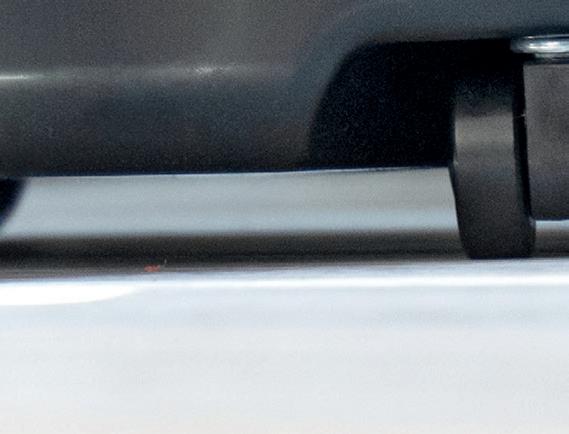














WORKS HARDER LASTS LONGER BUILT SMARTER Performance You Can Trust from the UK’s No.1 WORKS HARDER LASTS LONGER BUILT SMARTER Pro features include a high-efficiency TriTex filter, multi-surface ProFlo floor tool, long 10 metre hi-vis cable, and high-quality Stainless Steel tube set. Built for the long haul with a 2-Year Commercial Warranty and a motor designed and tested beyond industry standard. Made from minimum 45% recycled plastic, including all accessories, using ReFlo Technology. *UK’s No.1 Commercial Vacuum Manufacturer. Discover our sustainable ReFlo vacuum series at numatic.co.uk ERP180 PRP180 ©Numatic International Limited 2024 Made using recycled plastic
EASE THE PRESSURE
FMJ AIMS TO SUPPORT TECHNICAL EXPERTISE IN THE FM MARKET

James Massey, Managing Director of Facilities Management at MRI Software, looks at the challenging workloads FM professionals face, and the benefits to them of deploying tech
FMsjuggle a myriad of responsibilities. In addition to maintenance and repair, they increasingly need to provide more visible cleaning services, manage budgets and projects, improve communication with tenants and contractors, ensure health and safety compliance, find energy cost savings, champion sustainability, and track data and records in all these areas.
In light of these challenges, the strategic deployment of technology emerges as a beacon of hope, o ering solutions to streamline workflows and alleviate the burden on FM professionals.
A recent survey of 750 European FM professionals conducted by MRI So ware, sheds light on the pressing issues faced by this group. MRI’s Voice of the Facility Manager reveals that, alarmingly, 70 per cent of respondents admit to working beyond their contracted hours, with over a third (40 per cent) putting in at least 10 additional hours per week – and over one in 10 (12 per cent) putting in more than 20 extra hours weekly.
Only 16 per cent of those surveyed say they feel their workload is just right, with close to half (48 per cent) feeling it is “busy” or “far too busy”. While workloads have increased for the vast majority of FM professionals, just 30 per cent say their budgets have increased and 24 per cent reported that they have stayed the same.
Given the staggering workload faced by many FMs, with most budgets remaining tight, it comes as little surprise that mental health emerges as the paramount challenge, with 39 per cent of respondents identifying it as a critical issue.
POSITIVE POTENTIAL OF TECHNOLOGY
In the face of this emerging workload challenge and its impact on FMs, technology is emerging as a
transformative force, o ering digital tools to enhance e iciency, harness data, monitor buildings, manage energy usage, and predict maintenance needs.
years, signalling a paradigm shi towards digitalisation.
» Over a third (35 per cent) of FM professionals have invested in artificial intelligence (AI) or automation so ware in the last 18 months, reflecting a growing appetite for cutting-edge solutions.
» 37 per cent have invested in userfriendly apps for end users to log their requests in the previous 18 months.


The survey underscores FMs’ growing recognition of technology as a vital ally in their quest for e iciency and productivity. Thirty per cent of respondents view new technology and digital disruption as an opportunity, while an additional 20 per cent consider them essential to embrace. Similarly, advanced data analysis and cloud-based data collection are perceived as key enablers, with 30 per cent of respondents


technology needs to make greater inroads to boost e iciencies that will relieve high workloads and o er more flexibility. Despite these trends towards innovative FM technologies, adoption of more sophisticated solutions is low in some quarters, with 13 per cent of respondents still using spreadsheets, an additional 12 per cent using a combination of so ware and spreadsheets, and eight per cent using no IT tools at all. Overall, 31 per cent say they are only somewhat satisfied with their technology solutions, and 17 per cent say they are somewhat dissatisfied.
TOWARD A BETTER-BALANCED FUTURE


identifying them as opportunities and 20 per cent as essential to adopt.
The report highlights a significant shi in FM professionals’ attitudes towards technology adoption.
This shi suggests the industry’s readiness to embrace technological innovation as a means of navigating the complexities of modern facilities management.
Key findings from the survey further underscore the evolving FM technology landscape, showing a shi to new technologies that are helping reduce workloads and improve the outlook for FM professionals:
» Over half (54 per cent) of respondents believe that FM will increasingly involve tech-enabled tools over the next five

» Over half (52 per cent) of participants say they are provided with su icient training to keep up to speed with current technology trends.
The report reveals that two-thirds (67 per cent) of the FM professionals surveyed are considering changing or adopting new FM so ware, with 38 per cent saying their aim is to boost e iciency and productivity. All respondents report using technology in some form, and 31 per cent say they are employing multiple systems. These include FM so ware (56 per cent), contractor management so ware (40 per cent), visitor management so ware (37 per cent), incident reporting so ware (37 per cent), and leasing so ware (33 per cent). There are still, however, areas where
The findings of MRI So ware’s Voice of the Facility Manager survey o er valuable insights into the challenges and opportunities facing FM professionals in today’s fast-paced environment. While heavy workloads and mental health concerns loom large, technology presents a pathway towards greater e iciency, productivity, and wellbeing.
Seeing conditions improve with the aid of technology will enhance the outlook for FM professionals. Despite the challenges posed by heavy workloads and the need to continue investing in FM technologies that improve the situation, 60 per cent of respondents maintain a positive work-life balance, indicating resilience and adaptability within the FM community.
By embracing digital tools and harnessing the power of data, FMs can not only ease the pressure of their current workload but also futureproof their roles in an increasingly complex and interconnected world. As the FM industry continues to evolve, maintaining a strong focus on work-life balance and wellbeing will be crucial in attracting talent, fostering growth, and delivering value to organisations worldwide.
www.mriso ware.com/ae/resources/ vofm-emea-report
APRIL 2024 16 ADVICE & OPINION
FAST FACTS


Guenaelle Watson linkedin.com/in/ guenaelle-watson-111758a - 15% to 20% of the population is neurodiverse according to official stats. But in reality, with many conditions falling under the Neurodiversity umbrella it could be up to 40% - nearly half the population! Hence the importance of catering for a range of needs in our workplace environments.Thank to those who attended our Neurodiversity in the Workplace event as part of #neurodiversitycelebrationweek
@CHTToday Tork promotes sustainability and hygiene at Interclean - https://bit.ly/3vvTAS6

The British Cleaning Council @BritishCleaningm This year’s @TheCleaningShow in Manchester was a huge success - with a massive increase in attendees and around double the number of expert speakers https://bit.ly/3IVXuXy
Lucy Hind https://www.linkedin.com/in/ lucyhind/ I do not often post on LinkedIn about personnel things but this year (2024) I am doing the April London Landmarks 1/2 marathon... I am thankful that my very good friend Lesley Jepson will be also be doing the event with me as my support runner. It may be a walk / run (may end up a crawl) due to having a hip replacement June 23 & a knee op in Dec 23, further ops in May 2024 but I am still at it.... cancer & ops don’t stop me! It’s a big thank you to Macmillan for arranging for the support person for me. I am still on chemo & bone drugs so we want to raise awareness and funding for the amazing charities that are From Me To You & Macmillan. If you can support it would be amazing and a massive thank you.
https://lnkd.in/exSq_iP6

https://www.linkedin.com/company/theanti-greenwash-charter/ We’re thrilled to announce one of the UK’s leading flooring companies, Karndean Designflooring UK, has become the latest certified signatory of #TheAntiGreenwashCharter. To see a company of such influence taking this proactive step is huge for our movement. It’s been great working alongside Jamie, Laura and Gavin in co-creating the company’s #GreenClaimsPolicy. Thanks for all your input. We’re excited to continue partnering with their team as we roll out a number of new verification practices and tools over the coming months. Stay tuned for more.

RICHARD SYKES, SVP AND PRESIDENT, ABM UK AND IRELAND
NAVIGATING THE FUTURE OF FM
An ancient philosopher said that “the only constant in life is change”; that is truer today than ever before. The facilities management industry is responding to everything from technological advancements to evolving workplace dynamics; a plethora of changes which are influencing how we deliver our services. For me, there are three overarching considerations for the immediate and long-term, and the way businesses evolve and adjust to these influences will determine their future success.
AI and robotics
The world is talking about artificial intelligence with both trepidation and excitement. Forwardthinking FMs recognise the immense potential of technology to enhance e iciency, reduce costs, and elevate service quality.
Smart buildings integration is at the forefront of this. From IoT sensors optimising energy consumption to AI-driven predictive maintenance, enhancing e iciency and sustainability credentials will top the list of priorities.
When looking at security and safety, embracing artificial intelligence is less of a commercial choice and more of a necessity. Intelligent surveillance systems which recognise anomalous patterns can alert security personnel to potential threats and emergency response systems can also be optimised ensuring swi and e ective actions during critical situations.
AI algorithms can analyse patterns and anomalies in real-time, providing proactive security measures to prevent incidents rather than simply responding to them. The combination of AI and robotics in this domain has led to more robust, intelligent, and responsive security systems and it is something all security providers should be embracing.
Finally, data is and will be everything moving forward, but it needs to be consolidated. Customers are relying more and more on FMs to provide data that helps with sustainability e orts, provides increasing benchmarks and ultimately improves e iciency.
For us, this is a two-pronged approach:
First, our focus on integrating service lines with individual clients means data is easily accessed rather than being disjointed from di erent providers. It also means e iciency objectives are met much more easily. Secondly, delivering this relies on using all the technology sources available to ensure the data output is consolidated, accurate, and compelling –including AI.
The EV opportunity
While Rishi Sunak pushed the ban on sales of new petrol and diesel cars back by five years at the end of last year, the zero-emissions vehicles (ZEV) mandate still suggests that the vast majority of UK car sales will be electric in the near future, meaning demand for new chargers is still strong. The government target of 300,000 public chargers by 2030 means the UK has a gap of approximately 250,000 chargers to fill in six years.

This is an enormous opportunity and with a plethora of government initiatives and incentives to accelerate the adoption of electric vehicles, we are advising customers that now is the time to invest in infrastructure, especially as part of a wider energy solution strategy.
Likewise, EV charging stations present a unique opportunity for commercial property owners to generate additional revenue. By setting competitive charging rates or o ering subscription-based access, they can turn EV charging infrastructure into a profit centre. This added income can o set installation and maintenance costs while providing a valuable service to tenants and visitors.
The evolution of customer expectation
Customers are under increasing pressure to demonstrate rapid progress on the ESG and DE&I front and that extends to the company they keep in the form of suppliers. Our industry can help or hinder that progress for customers and so it’s imperative we move forward at pace, ensuring we are leading so that prospects see us as good company to keep.
To deliver this, collaboration is key, which is why ABM has recently become a Business in the Community partner; joining the largest and most influential responsible business network, supported by His Majesty the King for over 40 years. We will continually take steps to improve and call on the knowledge and expertise of like-minded businesses to share best practice and innovation to work together for ethical and commercial success.
Secondly, the hybrid work model is here to stay, and facilities management must adapt accordingly. As more employees split their time between o ice and remote work, our industry will see an increased demand for flexible solutions that optimise spaces for both in-person collaboration and virtual productivity and this will be a continuing trend as the country adjusts to a new working world.
The near future is dynamic for facilities management in the UK and Ireland, with opportunity at every turn for those who are prepared to lead through innovation, sustainability, and a commitment to excellence.
SOCIAL - BLOG APRIL 2024 18
Richard Sykes, SVP and President, ABM UK and Ireland
ADVICE & OPINION

The role of Heavy Duty Cutting and Workbench Protection Mats in Advanced Manufacturing
75%
Up to Increase in life expectancy over other surface solutions
Up to 65% Increase in Speed, accuracy and user safety when cutting & trimming
Up to 68% Improvement in preserving work surfaces and protecting products being worked on avoiding cross contamination
Up to 50% Reduction in replacement tool costs by extending tool and blade life




The last few years have seen notable changes in legislation and regulations within the FM space such as the Fire Safety Act 2021, The Building Safety Act 2022 and the Fire Safety Regulations (England) 2022, to name a few. These changes in the industry have forced a shi in priorities and duties within the built environment. Which areas do you think will be particularly impactful for those working in FM?
maintenance. Despite its cost-e ective potential and collaboration with industry specialists, outsourcing maintenance tasks makes it more di icult for facility owners to have both visibility and control over the standard to which tasks are completed.
Enhanced connectivity is another priority. FMs and property managers are under the strain of managing extensive workforces to ensure the safe and legal maintenance of a facility. The presence of various stakeholders tends to make streamlined collaboration much trickier. In particular, ensuring the right people receive the necessary information at the right time becomes a challenge.
In FMJ's regular monthly column, our team of FM experts answer your questions about the world of facilities management
INDUSTRY STANDARD FOR BUILDING MAINTENANCE SPECIFICATION’S VIEW
PAUL BULLARD, PRODUCT DIRECTOR AT SFG20
With the constant evolution of legislations and regulations within the FM industry, uncertainty of what tasks should be completed, how o en and by whom is on the rise. We will, therefore, continue to see a greater spotlight placed on proof of compliance with building compliance in the spotlight.
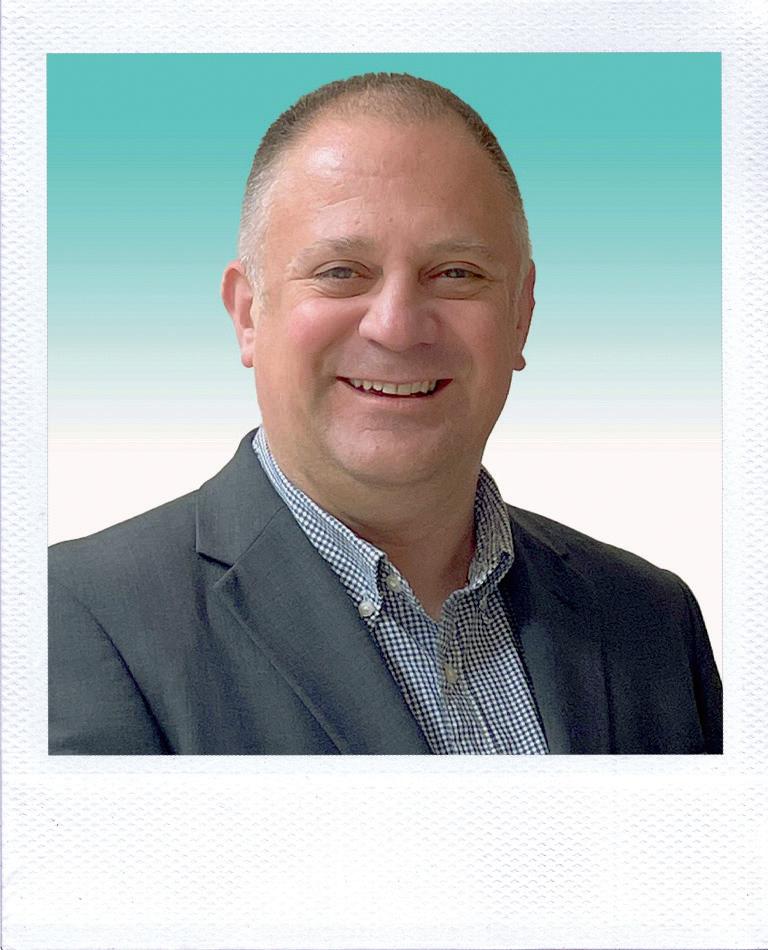



The Government has also ensured it will increase the number of buildings that fall within the scope of the Building Safety Act. This will make providing a thorough, digital trail of maintenance tasks a requirement for many more. Building owners, property managers and contractors will need to ensure that statutory maintenance works are being carried out, that the information is up-to-date and that evidence can be provided.
Competence will be crucial. This means ensuring that maintenance tasks are being undertaken not only at the right time but also by the right person for the job is a high priority for facility managers this year. This becomes a particular concern when a facility outsources a large proportion of its
In a recent poll conducted by the experts at SFG20, 66 per cent of asset owners and property managers revealed that keeping a golden thread of information about a facility up to date has been a main concern for their business. This shows that many current FM systems are not aligning in a way that helps facilitate e icient, collaborative working.
Developing and providing so ware solutions that enable teams to share data and work e iciently will continue to characterise industry changes in the near future.
The growing importance of AI will continue, because it o ers the potential to enhance rather than replace human roles in FM, unlocking new opportunities. The technologies available facilitate businesses to work with larger datasets for predictive maintenance, providing a time-e icient and proactive approach to facility management.
Businesses are still under pressure to develop the necessary skills to successfully work alongside AI technology for predictive maintenance, data analysis and a cost-e ective allocation of budgets. With the current focus on compliance, facility managers will be challenged with reducing costs, an obstacle that an e ective use of AI could help eliminate.
Finally, sustainability will remain at the forefront for many in FM. The landscape of the UK's built environment is on the brink of a profound transformation. The march toward carbon neutrality is poised to accelerate, propelled by technological strides, evolving governmental policies and heightened public climate awareness.
To mitigate the continuing rise in carbon emissions, we must carefully consider and implement ways to reduce greenhouse gas emissions, such as improving the energy e iciency of existing buildings through sustainable maintenance and ensuring that new buildings incorporate this into their initial design.
APRIL 2024 20
FM CLINIC
ADVICE & OPINION
Paul Bullard
THE WORKPLACE COMPLIANCE CONSULTANT’S VIEW
GREG DAVIES, DIRECTOR OF MARKET DEVELOPMENT, ASSURITY CONSULTING
Over recent years, the Fire Safety Act 2021 and Building Safety Act 2022 have seen significant change in how multiresidential buildings must be managed - (buildings containing two or more sets of domestic premises), and high rise multi-residential buildings (HRRB) (buildings containing two or more sets of domestic premises which are 18m/7 storeys high (whichever is reached first)). They have also seen a much greater emphasis placed on the ‘whole of life’ safety provision within new or refurbished buildings falling into scope, at design, construction, and occupation.

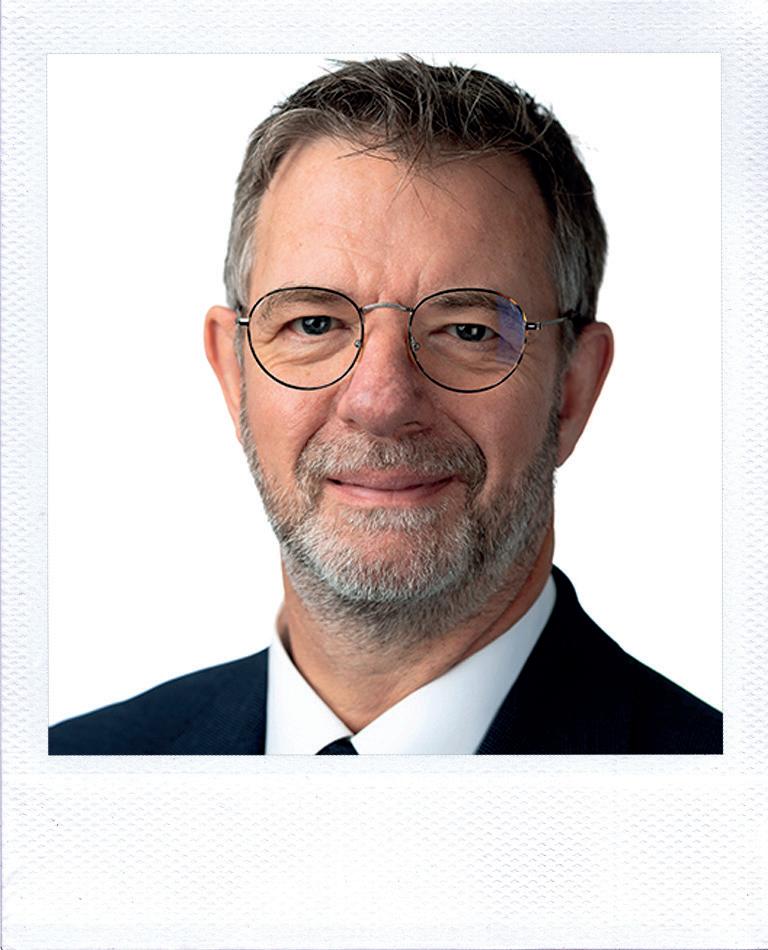
Greg Davies


While the focus, as a result of the Grenfell Tower fire in 2017, has been on residential properties, there are few who do not see similar requirements improving safety in others sectors too. These changes are not the only ones in place or in the pipeline, other examples are:
February this year saw the Government appoint Dame Carol Black to lead a new taskforce on Occupational Health in the workplace, with the aim “to tackle in-work sicknesses and help grow the economy”. With only 45 per cent of workers in Britain currently having access to some form of Occupational Health service, the taskforce is looking to produce a voluntary occupational health framework for businesses, which will be due out in the Summer.

Also, in February the dra Terrorism (Protection of Premises) Bill (also referred to as Martyn’s Law or the Protect Duty) went out to consultation. As a consequence of the tragic Manchester Arena terrorist attack in 2017 Martyn’s Law - named a er Martyn Hett who was killed alongside 21 others at the event - the legislation, once enacted, will impose requirements on premises and events in relation to “preparedness for, and protection from, a terrorist attack by requiring them to take proportionate steps, depending on the size and nature of the activities that take place at the premises”. Currently public premises with a 100 capacity or more (standard tier) and then those with a capacity of 800 or more (enhanced tier), will be required to put in place relevant additional measures.
The Corporate Sustainability Reporting Directive (CSRD), which came into force across the EU on the 5th January 2023, sees greater rules on company reporting of social and environmental information. While we are no longer part of the EU, non-EU companies generating over €150 million on the EU market, will also need to report. The requirements will come into e ect for the 2024 financial year for reporting in 2025.
What is also stark about this pipeline of changes is that they all impact workplace and facilities. If not directly, there will be aspects of each that do, and this will once more put a spotlight on our profession. They are also opportunities for us to not just fanfare the problem-solving ability we already have but make FM a real and positive agent for change. Where the legislation may create the business need it is FM that has the ability to provide the solution.
THE SMOKE AND FIRE EXPERT’S VIEW CONOR LOGAN, TECHNICAL DIRECTOR, COLT INTERNATIONAL
There have certainly been some notable changes in fire safety legislation and regulation in the last few years that building owners and managers need to pay attention to.
With regards to smoke



Conor Logan

With regards to smoke control in buildings, the Smoke Control Association published the SCA & FMA Guide: Smoke Extract Fan Maintenance in 2021, which looks at the maintenance of smoke extract fans – an important safety aspect in buildings that o en gets overlooked. This best practice guide can ensure that your life safety equipment is fit for purpose and it is recommended that all service engineers are familiar with its contents.
There are several issues that require special attention from facilities managers and other building managers:
Testing, service, and bearing check intervals: Following BS 9999, a smoke control system should undergo weekly testing,
APRIL 2024 21 FMJ.CO.UK FM CLINIC
ADVICE & OPINION
FM CLINIC
with a comprehensive system test conducted quarterly. Service intervals are recommended every six months and bearing checks are advised every three months— an increase in frequency compared to previous practices. As well as doing all necessary checks at each test, engineers must also check building records each time they visit to ensure that weekly testing is taking place.
Smoke extract fans manufactured before 2005: Fans produced before 2005 are unlikely to have undergone testing or certification to the European Standard EN 12101-3. While it's not a legal requirement to replace them, the guidance recommends replacing these fans with certified products. CIBSE guidance suggests a maximum service life of 30 years for smoke extract fans, emphasising the importance of factors like environmental conditions and usage frequency.
Smoke extract fans manufactured a er 2005: Fans produced a er 2005 should be maintained and replaced if they deteriorate beyond acceptable limits or if their service life, according to CIBSE guidance, has expired. The decision to replace rests with the building owner and/or manager, but the service engineer plays a role in presenting evidence and data to inform that decision, considering the potential risks associated with failure in life safety installations.



reports are now being requested as standard. Many clients are now much more knowledgeable on these subjects with increases in webinars and online information. Understanding that they might be cross-examined in an inquiry situation has focused attention. As a service provider in this area, it’s a welcome change following a tragic event.
The Building Safety Act and the associated implementation of ‘The Golden Thread’ throughout the entire lifecycle of a building, together with the additional scrutiny a orded to highrisk buildings over 18m high with two residential units, will make service provision within acute healthcare, student accommodation and high-rise housing sectors more di icult. But nothing is impossible, and the reality is that our industry needs to help real estate owners deal with these challenges.


Re-wound motors: While common in service and maintenance, re-winding motors for safety-critical components like smoke extract fans is not advisable. Unless re-wound by the original manufacturer or a licensed specialist to the exact specifications, a re-wound motor may not perform as well as the original. High-temperature motors, crucial during fires, should only be replaced with new motors of the same type and performance from the original supplier.



Use in fire: Smoke extract fans are designed for single high temperature use. Any fan that has been exposed to a fire situation should be replaced, regardless of the results of any post-fire performance tests that have been carried out.
These latest changes in regulation will not be the last and show how important it is that building owners and managers adopt a proactive approach to fire safety to ensure the safety of their tenants, buildings, and stock.
THE FM SERVICES SUPPLIER’S VIEW
ANDREW LUNT, MANAGING DIRECTOR, ATLAS WORKPLACE SERVICES
As the investigations into the Grenfell Tower disaster rumble on, we have noticed a significant and very positive step change in the way clients view the risk of fire.



There is more attention being put on the safety of building occupants provided by fire doors, fire dampers, fire alarms, and all fire protection systems within a building. Improvements in record keeping, more detailed logbooks and photographic service


The second major concern for service providers that flows from these changes is competency. The Grenfell Tower inquiry has shown very publicly the intense scrutiny that both businesses and individuals will be put under in similar circumstances.”
AndrewLunt







Currently, CAFM systems tend to be structured to hold data to form an e ective planned maintenance regime and record statutory compliance. There will need to be a move to hold asset data in a more structured way to demonstrate systems function and asset association, so that all the parts of this huge puzzle can be clearly understood and withstand external audit and client review. Currently, there is no standard solution for this. However, we are seeing more discussion around ISO 55000 and asset management standards across property portfolios.











and the reality is that our industry clearly no
The second major concern for service providers that flows from these changes is competency. The Grenfell Tower inquiry has shown very publicly the intense scrutiny that both businesses and individuals will be put under in similar circumstances. Again, intelligent clients are now asking for much more detail around the competency of engineers and subcontractors: how they are assessed, what the management and appointment process looks like, and how this is evidenced.
It is probable that responsibility for managing things will become more onerous as time passes. For example, there will be the requirement for a robust appointment process, with the associated documentation trail, and a suitable and su icient safe systems of work policy with a full suite of permits.
Linking this together, we have concerns over a potential increase in less scrupulous contractors looking to capitalise on such changes and perceived risks to building managers. We have seen fire door surveys that recommend full replacements where repairs would be perfectly feasible. There is a real risk that building owners and managers will be scared into carrying out works that are not required. In an already tight financial environment, clients could waste precious funds that could be better used on improving infrastructure and the workplace experience. Let’s help our clients make good decisions while ensuring the safety of their buildings and their inhabitants.
Do you have a question that you’d like answered by the FMJ Clinic?
Email: sara.bean@kpmmedia.co.uk
APRIL 2024 22
ADVICE & OPINION
Andrew Lunt
maintenance, re-winding motors for safety-critical components like smoke extract fans is not advisable. Unless

Peace of mind and superior service with real time pest monitoring from Pelsis

Pelsis' new intelligent insect light trap gives real time insights and data access, when and where you want it.
Monitor flying insect activity remotely in real time with our easy-to-use app and web platform.
Reliable notifications at your fingertips allow early intervention and increased customer satisfaction.










Delivers an easy technician experience with reduced ladder usage and more productive time on site.
The all-new intelligent insect light trap from Pelsis. Pest monitoring made simple. Intelligent




Pest Management Solutions For a free demonstration contact sales@pelsis.com pelsis-pro.co.uk | 0800 988 5359

MAKING CONNECTIONS




Kean Jones, Chief Technology O cer at the Government Property Agency describes the work the team at the GPA have been doing on connectivity across the estate
The dust is now settling on the great workplace disruption – hybrid models have become the norm for many, with the number of people doing a blend of home and o ice-based working rocketing from 10 per cent in 2019 to nearly one third of the UK workforce by 2023, according to the O ice for National Statistics.
This shi has brought with it a dramatic change in people’s expectations of the o ice. Employees want more from spaces – more sociability, more flexibility, more connectivity. They expect a seamless experience that unlocks all the benefits of being with colleagues and incentivises a
departure from the comforts of WFH.
It’s a story we all know well, but the challenge now is how to deliver o ices that fit this brief. At the Government Property Agency (GPA), smarter use of technology and data has been at the core of our strategy to create great places for Civil Servants and put teams at the heart of the communities they’re serving.
LESS ISN’T ALWAYS MORE
For some organisations, the answer to how to meet employees’ new needs has been estate rationalisation – streamlining sites and pulling together dispersed workforces
into centralised hubs and campuses which o er the dynamic, collaborative environments that people want. This mentality has formed part of our roadmap too.
Through our Government Hubs Programme, we are creating multidepartment centres across the country, bringing together Civil Servants from a variety of di erent teams. In Darlington, for instance, we are delivering an economic campus which will be home to 1,400 relocated roles and nine government departments, including HM Treasury. While this approach has its merits,
APRIL 2024 24 CASE STUDY GOVERNMENT PROPERTY AGENCY

THE GOVERNMENT PROPERTY AGENCY IS DELIVERING ONE OF THE LARGEST WORKPLACE TRANSFORMATION PROGRAMMES IN THE UK:
Managing nearly one million square metres of the Government’s property portfolio – 45 per cent of the government office portfolio.
In 2022-23, the GPA invested £215 million in its estate, including £76 million in condition improvement works.
Providing workplace services to 163 clients and over 150,000 customers.
Supporting the relocation of up to 22,000 Civil Service roles out of London as part of the Places for Growth programme.
Bringing forward the Government Hubs Programme – creating modern, shared workspaces where Civil Service teams can collaborate and work productively. This includes the new Darlington Economic Campus, which will be home to nine government departments including HM Treasury. It is due to be completed in 2026.
Achieved Leesman+ certification for the Birmingham hub, with a score that places it as the best employee workplace experience in the UK’s public sector.
there is a balance that needs to be struck. Recruiting a wide range of talent is essential for any organisation to provide diversity of thought and expertise, and by having a footprint in multiple towns and cities, firms can ensure they are tapping into a broader pool of people. This has been a priority for us, with one of our core objectives being to ensure that government careers are accessible to individuals right across the UK.
So how can occupiers marry a more centralised approach, with greater connections across teams and
opportunities for them to collaborate, while maintaining a regional presence? Our solution has been the development and roll out of GovPass, a unified and standardised access system which gives Civil Servants the freedom to work from buildings across the government property portfolio.
BRIDGING THE GAP
GovPass has given our customers both flexibility and convenience. Whether they need to book a meeting room, print o resources or connect to the Wi-Fi, Civil

APRIL 2024 25 FMJ.CO.UK GOVERNMENT PROPERTY AGENCY CASE STUDY

In the interest of maximising flexibility, we deliberately designed GovPass so that it could be rolled out across all of our buildings –the old as well as the new. This came with its challenges, of course...”
Servants can make use of all the facilities and AV equipment available at an o ice, without special permissions. It provides a hassle-free experience and allows people to use their time as productively as possible, rather than trying to grapple with tech and admin.
The system is now in operation across 47 sites, covering 110,000 Civil Servants, but when it was first conceived, nothing quite like it existed. We had a clear idea of what we wanted and we worked with expert technology providers to make it happen. Together, we bridged the gap between traditional access control platforms and aggregated data tools to push the boundaries and hit our three priorities: creating a single system that is secure; gives users tailored access to facilities with one card; and can capture data to inform our plans for the estate.
COME TOGETHER
GovPass is not only facilitating joined-up working between Civil Service teams, it’s also making sure they can make the most of our wider property portfolio. If a Civil Servant is working on investment policies for di erent parts of the country, they can now do that from a regional hub or satellite o ice – bringing them closer to the local context and enabling better decision making.
In the interest of maximising flexibility, we deliberately designed GovPass so that it could be rolled out across all of our buildings – the old as well as the new. This came with its challenges, of course, but the benefits have been worth it as more people can enjoy working from some of the iconic, historic buildings in our estate. That brings a real sense of pride for many.
DATA FOR LATER
The inclusivity of the GovPass system has meant that all our assets can be brought on the digital transformation journey together. With that breadth of scope has also come valuable data about patterns in how people are using our buildings. The criteria for what’s best in class for workplaces will continue to change, so having this insight is vital to make sure we keep pace with behavioural trends, evolve facilities in the right way and continue to improve our buildings for the people using them in the future.
While the rate of change that we’re currently seeing in the o ice sector can be daunting, there is also huge opportunity for estate managers to benefit if they arm themselves with the right tools. By embracing technology and drawing on data, we are maximising value from our portfolio and helping to create environments where Civil Servants can deliver their best work.
We’ve already seen the advantages of a digital-led approach with the roll out of GovPass and hope others across the industry will follow our lead – pushing the bar of what’s possible when it comes to the workplace and employee experience.
APRIL 2024 26 CASE STUDY GOVERNMENT PROPERTY AGENCY

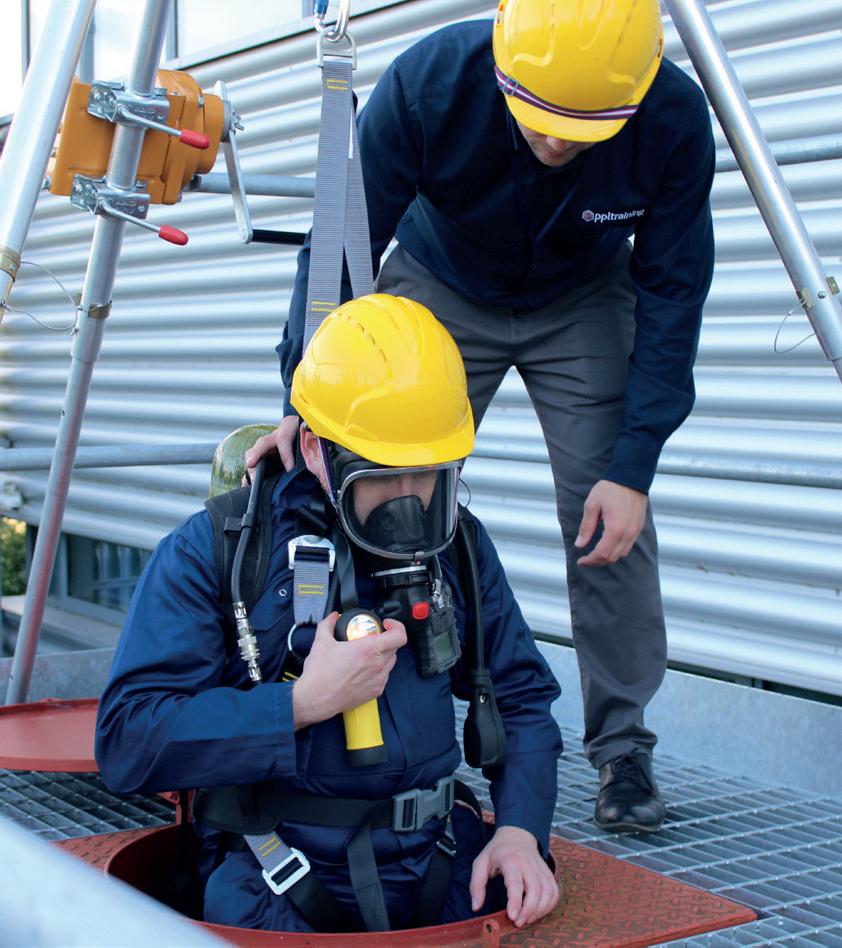

0333 121 0381 Call our team today fmj@ppltraining.co.uk go.ppltraining.co.uk/fmj visit our website We offer City & Guilds Assured courses and City & Guilds Qualifications covering all aspects of Mechanical & Electrical engineering and maintenance, including: Available in York, Slough, Livingston & On-site at your premises Safe Systems of Work & Technical Training for FM’s & Their Teams High Voltage Low Voltage Lifts Ventilation Fire Safety F-Gas Handling Legionella (Water Hygiene) NEW FOR 2024 Steam Boiler Operator Electrical Installations Confined Spaces & Working at Height Medical Gas Pipeline Systems Mechanical & Pressure Systems Aeronautical Ground Lighting (AGL) Facilities Management Technical Awareness Training for FM Contractors

DATA-LED DECISIONS
FMJ in partnership with property operations platform Facilio brought together a group of FM thought leaders from both client and services-provider backgrounds to discuss whether taking a tech-centric approach can help organisations transition to data-led building operations and achieve their net zero goals faster
PARTICIPANTS
• Sara Bean, Editor, FMJ
• Prabhu Ramachandran, Co-Founder and CEO, Facilio
• Ryan Yates, Senior Account Executive, Facilio
• Jo Bishop, Head of Estates Information and Systems, University of Warwick
• Russell Burnaby, Head of Facilities, Brent Council
• Nicholas Greenwood, Head of Facilities, AQA
• Monica Guise, Director of Facility Services, The University of Birmingham
• Julie Hogarth, Head of Sustainability, JLL
• Adrian Johnson, Co-Founder and CEO, Elyos Energy
• David Lam, Business Development Director, Vertiv
• Hetesh Pal, Principal Building Intelligence Engineer, Hoare Lea
• Fiona Sawkill, Head of Digital Placemaking, British Land
• Luke Lester, Deputy Head of FM Operations Southwark Council
• Matthew Scotchmer, Facilities Management Specialist, CBRE
• Ian Wade, Head of UK Estates, BMA
The FM sector has experienced growing demands to deliver sustainable and cost-e ective operations. A recent FMJ readers survey revealed that capital works and lifestyles cycle management are a key priority, with some form of digital asset tracking seen as a crucial way of monitoring buildings.
The survey also found that FM’s are prioritising investment in FM so ware to help create operational strategies that help enhance performance. However, many are also trying to determine which of these solutions are right for their needs.
Prabhu Ramachandran, CEO and Co-Founder of Facilio, was concerned many of the existing legacy CAFM systems are not suitable for current demands.
“CAFM systems were created as a system of record keeping of assets, but in the last few years, particularly a er COVID, FMs need so ware tools that help them make data-informed decisions. They need to know how their buildings are performing across sites, how to optimise resources and reduce costs, and in the case of public facing properties, how to enhance the customer experience.
“Compare it to other industries. Let’s take for example a banking app. Twenty years back it was based on physical presence, now, most of the banking is done
APRIL 2024 28 FOCUS TECHNOLOGY
ROUNDTABLE

through apps. So, while the world has become more sophisticated, facilities leaders are still working with older tools. That was what prompted us to ask, ‘how do you create a system of action which leaders can use every day to make their decisions?’”
KEY PRIORITIES FOR FM
According to both the client and services providers on our panel, how to get to net zero was a prime concern, coupled with how to pay for it given current budget restraints. However, it’s not just about heading towards net zero. One of our panellists from the education sector commented that it’s also how, “we evidence that as well, having that trust in the data and the systems and pulling through the right information so that you can honestly say that there is trust in the data, especially on big campuses”.
Cost is also a big challenge for local authorities as the public sector has a lot of well publicised challenges around budgets, and, as they’re likely to be there for years to come, local authorities are constantly being asked to do more for less.
From the FM’s supplier point of view, clients’ main focus is also on achieving net zero. However, to succeed they require insights on how their buildings are operated and crucially, how they’re performing.
A panellist remarked: “Having some data is more impactful than we imagined and being able to look at the data year-on-year is very advantageous.”
The panel also agreed on the huge impact that the emergence of hybrid working has had on the way we manage our buildings. They believe the existing building management systems were designed for the previous world and not for the current ways of working.
Remarked a contributor: “Since COVID we’re seeing loads of increases in electricity and people asking ‘what’s wrong with our asset?’ There’s nothing wrong with the asset. It’s just data for the last two to three years which has been inconsistent with how the building was intended to be used or where we are now at this moment in time.”
CAFM ISSUES
Turning to issues regarding the use of existing CAFM systems. According to our panellists, too many systems are poorly set up and won’t connect with other tools or systems. Within larger organisations many are not making the best use of their so ware, with communication being a particular issue. For example, there is o en a disconnect between an issue being reported on a help desk and the problem being resolved to everyone’s satisfaction or knowledge.
issue that arose when they moved over to a new contractor only to discover the previous data wasn’t as accurate as it should have been, leaving the team a lot more work to do in trying to gather asset verification.
Ryan Yates, Senior Account Executive, Facilio explained: “More o en we’re seeing people come to us with this issue where the FM service providers own the CAFM system and they realise they’ve been doing this wrong for 20 years by losing important data where they should be able to own it and have that historical record.”
Another important concern for our panel was having access to too much data coming from di erent sources and being unable to determine what is ‘the single source of truth’. Said one: “Do you really need that device to spit out information every minute? Can you reduce this down to half an hour or until something really drastic happens?”





This requires the system to make reporting easier, yet there were complaints: “The thing we hear more than anything is that we have a CAFM but it’s not doing everything it is supposed to - I still have to pick up the phone, look into Excel sheets, send emails.”








complaints: “The thing we hear more than anything
Technology’s great and we want the latest and greatest but there’s always a balance in requirements as it needs to actually deliver something that’s helping you achieve net zero, while reducing costs...”





Prabhu Ramachandran wondered why a CAFM system couldn’t operate like a tenant app?
“With this approach,” he said, “I can just take a picture, raise a request and it automatically finds who’s the vendor to be assigned to resolve that issue.
“In that scenario we connect with people, by allowing them to interact with the CAFM system through simple user-friendly apps. We can even integrate with WhatsApp, where people can send a message which can automatically create tickets. This is easy to do and doesn’t need a lot of investment, yet they bring a lot more value immediately.
“Once you run the system for a couple of years, you get behavioural patterns, which tells you which building is performing better. What kind of problems are recurring. Which third party contractor is performing best.”
There are also issues around who exactly owns the data produced by a CAFM system. Is it the FM supplier or their client? A panellist recalled an


















supposed to - I still investing in the the organisation needs. but
Allied with this is the risk of investing in the latest ‘bells and whistles’ which don’t actually o er what the organisation needs. Commented a supplier panellist: “Technology’s great and we want the latest and greatest but there’s always a balance in requirements as it needs to actually deliver something that’s helping you achieve net zero, while reducing costs.
“We see it time and time again, where I think a lot of clients will jump to the latest technology and we might have to come in and burst that bubble by saying, you don’t need it, there’s probably a better way to do things.”

ROUNDTABLE APRIL 2024 29 FMJ.CO.UK TECHNOLOGY FOCUS
ROUNDTABLE

BUILDING USERS
A di erence between those who use the building and how the Building Management System (BMS) operates, is another issue, with the group asking how you can proactively fix problems in buildings while also handling the conflicting needs of end users. Said a panellist: “Your system should help your maintenance engineers to troubleshoot and identify problems, but then the building users need to be aware that a system is working as it was designed – even if the end user is frustrated because the temperature is too high or too low.”
Another added: “Your BMS engineer is under pressure to correct [the temperature] to the building users’ comfort, but actually if you do that, you’re potentially haemorrhaging energy, and you’re not working the build into its design.”
Over complexity is a big issue, agreed the group, with one participant recalling their visit to a landmark o ice building where the Smart Technology was so complex that end users couldn’t control everything in the room, resulting in having to call a building manager in to sort it out.
For Ramachandran: “My personal wish list would be to make the leaders who are choosing and paying for the CAFM actually use it, but a lot of times that doesn’t happen. But if they did, they will get information on how the buildings across their portfolio are performing and how end users are experiencing it. That’s the real value of a CAFM platform - when leaders have that information and they can actually take better action.”
SUSTAINABILITY
Supporting sustainability and specifically ESG goals is a key priority for FMs, and though retrofitting, for instance switching to LEDs or installing heat pumps can help address climate change, this is expensive and time intensive.
Yet according to Ramachandran there is another way: “Traditionally, sustainability has been looked at as complex. You need to budget, plan it for a few years, and only do big retrofits which are essential.
“But if you want to have a real impact, in terms of sustainability a lot more value can be derived by what we call a ‘digital retrofit’ which means integrating with the BMS, picking up data and looking at behavioural changes. You can then share that information with stakeholders, for example, occupants, tenants or third-party contractors defining their KPIs. This may sound complex, but in so ware-driven systems these can be done with minimal investment which can be leveraged to create more energy savings.”
Facilio has been working with retailer Robert Dyas, which wanted to improve their energy e iciency in their circa 100 stores. Although these stores are not fully automated and have no BMS – each store manager was instead given access to an app, which had a system of good behaviour, to remind them to turn down heating and switch o lights at night. By measuring the subsequent monthly metered data, stores were ranked based on how they were consuming energy. As a result, with little or no automation, the so ware solution
has helped them reduce energy waste across their chain of stores.
This focus on understanding consumption patterns and creating behavioural changes, the panel agreed, was a much more e ective and people-oriented approach to achieving sustainability. Another low-tech approach at one of the universities was, instead of the heating being activated on the first of October, it wasn’t switched on until the first of November – resulting in a saving of £15,000 a month, and supported by campaigns such as ‘bring your jumper to work day’.
But using digital data to help make subtle changes was also advocated by the group. A services supplier recalled using the data from the sensors measuring storey lighting use detected this was less of a requirement since the adoption of hybrid working patterns. The solution was to reduce the lighting down to run at 80 per cent and see if anybody noticed. Nobody did – so this policy was applied to the rest of the portfolio.
Access to benchmarking data is useful here too, with the panel agreeing that benchmarking against other buildings and even organisations can be a valuable exercise. As one remarked: “Sometimes you can assess your energy level, but you’re not really comparing it to what constitutes good practice. And, if your CAFM provider has a portfolio of buildings, maybe they can help you with some benchmarking.”
Concluding the discussion, we turned to the major roadblocks at the moment in the panel’s energy management strategy.
They stressed it was time sensitive, with organisations being overly concerned about how much time it could take to see the return on investment.
Commented a service supplier: “What we’re trying to do is be proactive, and go to our customers now that we’ve got data and say to them, we can see that your energy usage is too high overnight as we think some of the lighting and heating has been le on manual, which is using loads of energy.”
And, as Ramachandran concluded, in order to make real progress in combining digital solutions with sustainability, you should take a ‘crawl, walk, run’ approach to ensure you make incremental progress.
He said: “In a recent survey of 150 facility managers we conducted (State of Smart Buildings So ware 2024), 53 per cent of them said they were overwhelmed with choice overload due to the many point solutions available in the market, and they didn’t know where to start. The key to unlocking progress is to start small. Begin with perhaps a one-year contract, spend less money, try it out, get some quick wins, and then expand into other projects. Rather than coming up with a very big project, ‘land and expand’ is a better route to success.
“It’s not going to happen immediately, but once you have the right platform, you start acquiring data about your buildings, and you can actually carry out continuous improvements.”
APRIL 2024 30 FOCUS TECHNOLOGY
Transforming Service Solutions
Discover the Bidvest Noonan di erence.
Every day, we help customers get more value from their services, improving e ciency, sustainability, and service quality. With services ranging from cleaning to security, our teams elevate standards for quality and innovation. We recruit talented people, provide them with world-class training, and empower them to excel in their roles. By combining state-of-the-art technology, a data-informed approach and the right people, we transform service solutions to deliver exceptional outcomes. Our commitment to excellence is why customers choose us time and again.
Learn more: bidvestnoonan.co.uk








MVIRTUOUS CYCLE
Gemma Rigby, HR Director at Anabas believes in the creation of a virtuous cycle by linking employee health and wellbeing to engagement and performance
odern workplaces represent a much more dynamic landscape than they were even a few short years ago. Long-gone are the days when the norm was for entire company workforces to be in the o ice Monday to Friday, 9am until 5pm. Today, many organisations are embracing flexibility in when and where their colleagues work, an approach which is helping to enhance productivity and working relationships, support a more positive work-life balance, and widen recruitment opportunities. This shi has also strengthened what I refer to as the virtuous cycle








between workplace and employee. Today, more than ever, I see an interconnectedness between employee health, wellbeing, engagement and, ultimately, organisational performance.
Although the connection between employee wellbeing and performance has always been there, there is no doubt that this relationship has been emphasised more strongly since the pandemic uprooted conventional working patterns.

Countless studies continue to provide validity to the virtuous cycle analogy. Economists at the University of Warwick, for example, carried


32 FOCUS WELLBEING 2024

out a number of experiments in 2022 and found that happiness made people as much as 12 per cent more productive.
Global analytics and consultancy firm Gallup, meanwhile, routinely publishes research on the link between worker wellbeing and business performance. Indeed, the impact of wellbeing can have a tangible impact on the number of days lost due to sickness, productivity and retention of talent. Burnout alone, Gallup says, costs companies $322 billion a year in lost output.
WHAT FEEDS INTO THE VIRTUOUS CYCLE?
There are many components which combine to make the virtuous cycle between business and employee.
The first two centre around physical and mental health. Interestingly, the Gallup study finds that 75 per cent of medical costs accrued mostly due to preventable conditions, underlining the potential financial impact that an e ective employee wellbeing strategy can have on a business.
The case to promote and support healthy workers is straightforward but extremely compelling. People who are physically healthy are more likely to have the energy and stamina needed to perform well at work. At the same time, they are also less likely to be absent due to illness, which is key to reducing disruptions to workflows. Good mental health is also essential for concentration, problem-solving, and decision-making – when employees are mentally well, they are more engaged and productive.
wellbeing and convey a sense of worth to their workforce o en witness heightened job satisfaction and performance levels – this is because satisfied employees are more likely to put in the e ort and want to perform well.
The final element is employee retention, a huge priority for businesses given the competitive nature of the recruiting market in many sectors of the economy. Prioritising employee wellbeing correlates with higher retention rates, ensuring continuity and stability within the organisation. By creating a supportive work environment where employees feel valued and respected, companies can retain top talent and be more certain of fulfilling long-term strategies.
WHAT DO EMPLOYEES NEED FROM THEIR WORKPLACE TO THRIVE?
In an ideal scenario, all the above components will be working in harmony together and feed o each other. This is more likely to occur when employees’ needs are met across various dimensions, including the health and wellbeing aspects we have just described.







Indeed, there are several other needs that employers should be seeking to address. These include setting clear expectations and providing a clear understanding of roles and responsibilities, as well as autonomy to execute those responsibilities and take ownership of their work. Both will help to create a greater sense of empowerment.





The next element is work-life balance. Organisations which provide flexibility can help employees to manage their personal lives more e ectively, which not only helps to enhance overall wellbeing, but o en makes them more engaged and satisfied when working.
Stress reduction is another critical component of the virtuous cycle. In its study, Gallup finds that ‘engaged workers who are not thriving in their lives’, compared to those who are ‘engaged and thriving’, are 48 per cent more likely to encounter daily stress and 61 per cent more likely to be o en or always burned out. Employers that invest wellness programs and a healthy work environment can help to limit levels of stress.
Wellness programs can also boost employee engagement, which is the next key element in the virtuous cycle. Engaged employees are more likely to be committed to their work and perform at their best, therefore helping to produce better business outcomes than other colleagues. Indeed, companies with the highest rate of engagement are more than 20 per cent more profitable.
Job satisfaction and engagement are two closely related variables. Companies that prioritise employee

Engaged employees are more likely to be committed to their work and perform at their best, therefore helping to produce better business outcomes than other colleagues. Indeed,
companies with the highest rate of engagement are more than 20 per cent more profitable.”







Work also needs to be challenging enough to be intellectually stimulating. Meaningful and interesting work can be a strong motivator and help employees to feel engaged with and valued in what they do. Similarly, regular feedback and recognition for contributions helps to boost motivation and job satisfaction –employees thrive when they know their e orts are acknowledged.

work can be a strong







Acknowledgement alone, however, is not enough. Employees need to be assured that sustained e orts and success will translate into career development opportunities. Learning and development programmes are also key to this and help colleagues to see a path for growth within the organisation.
There are also cultural needs to consider, especially around alignment with values. Employees who believe in the company’s values are more likely to thrive, with a shared sense of purpose providing additional motivation to perform well.
Although we have set out some specific needs that are likely to be universally applicable, it is important to consider that everyone is di erent, and that people may prioritise these factors di erently. That said, addressing these needs collectively will create an environment where employees are more likely to thrive in their roles, and therefore loop into the virtuous cycle.
APRIL 2024 33 FMJ.CO.UK WELLBEING FOCUS
ADMINISTRATION TRANSFORMATION

IRoger Marks, Managing Director at Aeromark says it is time to ditch the manual processes and digitally transform your back-o ce processes
t’s surprising how many organisations still carry out their commercial processes manually, using multiple spread sheets and out-dated disparate systems that o en fail to provide all the information they need.
Gathering all the evidence to prove an invoice is accurate, for example, can require an enormous amount of unnecessary to-ing and fro-ing with lots of room for human error and giving little confidence to the bill payer about its accuracy. It’s the admin merry-go-round, created by admin, resolved by admin – with nobody challenging the processes they have been using for years.
Accurate invoicing is arguably the most important cog in the back-o ice machine. An unpaid invoice is way more costly than you think in terms of time and energy. Cash flow is king in any business and employing a team to chase debts and recoup fees, diverts resources that could be used on more productive activities. Of course, at the extreme end, there’s also the cost of out-sourcing debt recovery.
BILL PAYER CONFIDENCE
How many of your clients adhere to your payment terms? A high Day Sales Outstanding rate (DSO) will impact cash flow and delays are commonly due to quite valid questions from clients about rates, parts, times and completion.
The crux of the problem is that customers don’t have the information they need to make payment decisions because suppliers don’t present the information to prove billing accuracy. So, if you find yourself wondering ‘there must be a better way’ then it’s time to switch gear and find a solution to eliminate the, quite literally, millions of routine tasks, spreadsheets, paper, and manual touchpoints taking up unproductive admin workforce hours for not only invoicing but almost every back-o ice process.
HARD EVIDENCE
Imagine a world where all work history, including quotes, job sheets, parts used, rates, compliance certification, and customer signatures are all stored together. Alongside these, other important documents, photographic, and video proof can
also be placed so that everyone knows exactly what work has been done and the costs involved, followed by automatic invoicing as soon as the job is complete.
Digital transformation allows costs and charges to be automatically calculated. The right platform should be able to store, at a single point, contract data, schedules of rates, parts costs, and mark-ups so an engineer’s rates, parts use (both buy and sell per contract) are all captured and applied to a final invoice with all supporting documentation. This process is even more important when companies
rather than going through all their invoices for each job they have done, they just review and invoice. A well-built and fully customisable platform, can transform the review and invoicing process and when all the required data is available, makes it a matter of simply review and a click to issue. A posting file to your accounts package will ensure interdepartmental transparency and shared data (via portals or agreed channels) allows your customers to have everything they need to prove a job well done.
PARTS REPLENISHMENT
Another cumbersome process is van stock management. E ective parts management and automatic replenishment help you achieve the highest number of first-time fixes or ‘completes’ per day. The right back-o ice system should be able to automatically replenish van stocks based on the parts you will likely need for the asset you are working on. This also includes stock management in warehouses and forward stock locations/pick up drop o s.
This should extend to raising quotations, fixing lists, bills of materials, and managing the sales order process from inception to acceptance to delivery, installation, and commissioning.
within a group are sharing services and contra charging which can double the group’s admin costs when there is a non-systematic solution.
COMPLETE COMPLIANCE
Compliance and certification are another carousel for admin. Service organisations and their customers benefit hugely from the ‘belt and braces’ security o ered by a system that automatically confirms documentation is completed, and all essential compliance certification is visible and linked to invoices.
But why not also include surveys, new installation commissioning documents, and quotes for works above the approved contract rates? The ability to automate three-way matching, and for consolidated or part invoicing is another huge bonus. And if you use sub-contractors, you can provide them with a summary of work and a payment certificate that they invoice against –
Configurable so ware removes the risk of human error, and with accurate information, the possibility of disputes and delays to payment is reduced saving time for everyone. The benefit to the customer is just as great. Fully customisable invoices can o er full visibility of the fee for every aspect of a service call which means that customers understand exactly what they are being charged for. Branded customer reports can be automatically generated to ensure the customer has all the evidence they need to quickly sign o the work for digital invoicing and swi payment.
It’s time to ditch the paperwork, spreadsheets, and admin and let digital transformation ensure your clients have no doubts when it comes to paying their bills. And if you don’t think this applies to your business, follow a job around and see just how long it takes. Count the touchpoints. Every one of them costs time and money. So, is it time for your business to get o the admin merry-go-round?
APRIL 2024 34 FOCUS DIGITAL WORKPLACE



















Working beyond walls
Transform your spaces into dynamic environments and empower your members via innovative technologies fused with creative solutions.
From bespoke AV design and podcast studios to seamless connectivity and integrated security, iwGROUP keeps you ahead of the curve. This is coworking…redefined.


Experience the future of coworking with iwGROUP GROUP
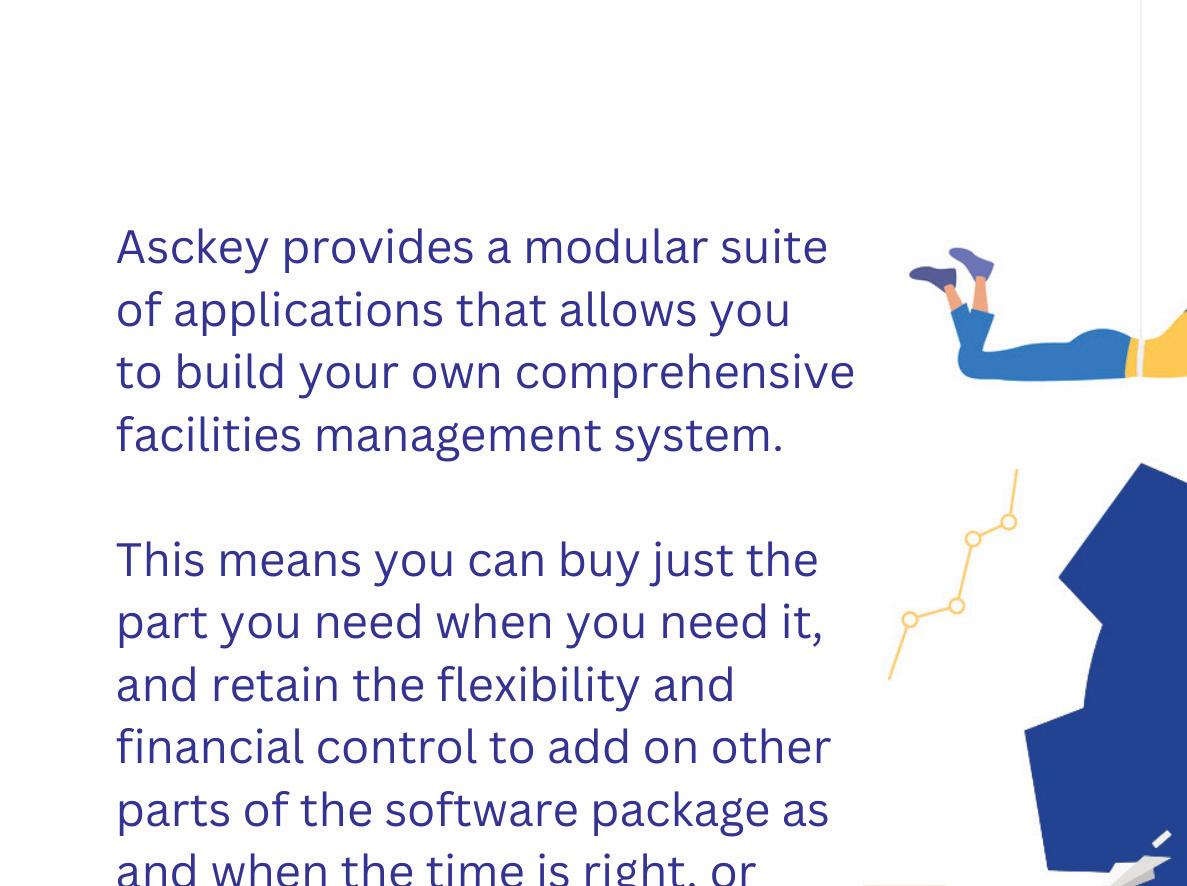
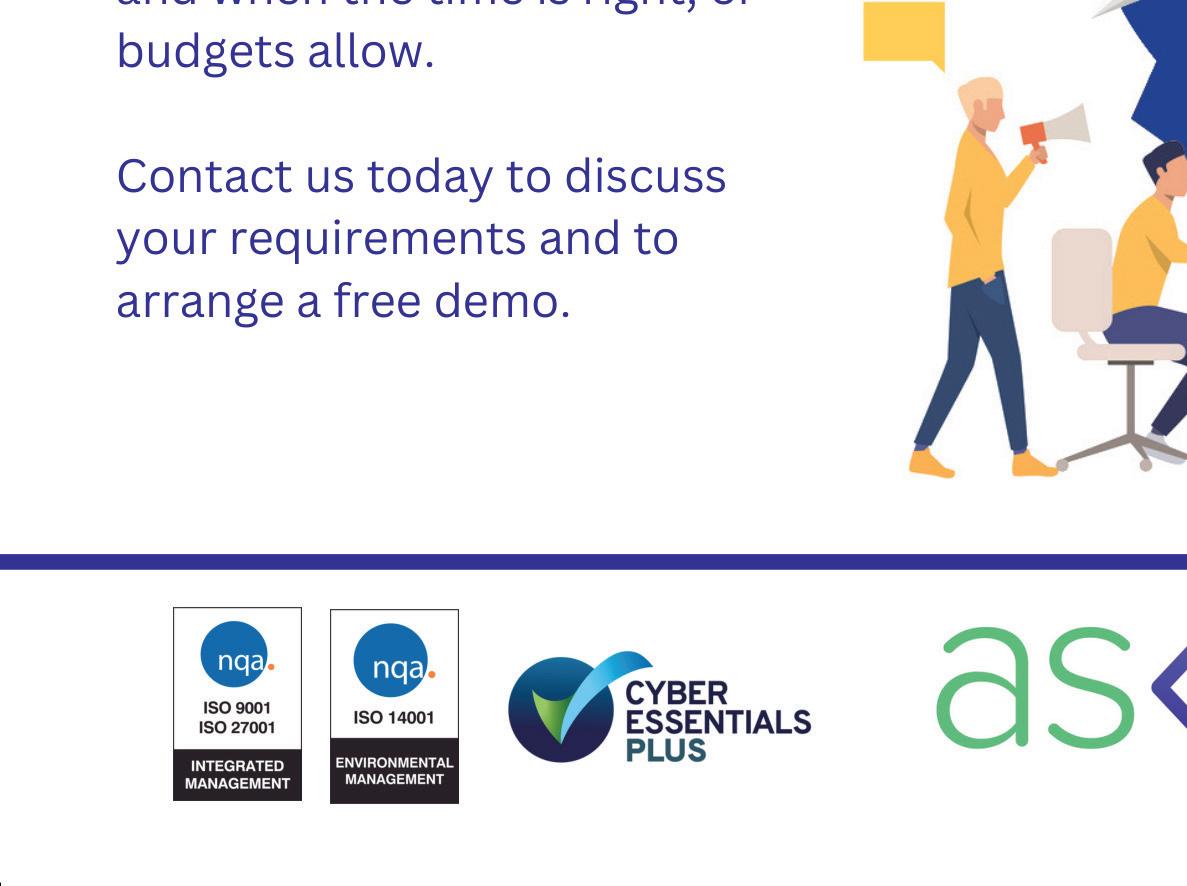



WWW.

DRIVING DECARBONISATION

The SFMI Scope 3 Framework is designed to positioning FM as a key player in driving decarbonisation through the supply chain. Chris Havers, Director at the Acclaro Advisory o ers some valuable insights into the project
Over the course of 2023, the Sustainable Facilities Management Index (SFMI) and a group of forward-thinking FM providers in the UK and Spain (BAM FM, Skanska, Bouygues E&S and Optima Grupo) embarked on an ambitious project. The aim was to set the industry standard for how FM providers measure their scope 3 emissions. Our approach has delved into the o en unknown and unmeasured territory to build a more accurate emissions impact for their activities and how they can be allocated to customers.
This project is part two of a four-phase project. Providing the FM with a tried and tested approach to measuring their scope 3 emissions, it can yield benefits for the FM industry as a whole. There are also growing drivers for this. New regulations are requiring the calculation of scope 3
emissions and assessment of climate risk. The SBTi (Science Based Target initiative) is now scrutinising the impact of use of services on customer sites as part of its validation process for SBTi approval. This requirement was not in place for FMs that set their targets in previous years.
So, what benefits does this framework give FM? It gives FMs the ability to work more closely with their customers and align with the ongoing need to achieve net zero carbon emissions, and it improves the industry’s reputation for delivering net zero emissions services in the future.
WHY? – 1. REPUTATIONAL BENEFITS
FM providers are increasingly marketing themselves as a service that can
APRIL 2024 36 FOCUS SUSTAINABILITY

help to achieve net zero for its customers. However, there has been a plethora of net zero targets being set by FM providers which incorporate a large range of activities in their targets, ranging from direct emissions only, to those aligned to wider Carbon Reduction Plan categories. Given the fact that many large FMs are now showcasing themselves as a form of transition industry, this inconsistency shows a lack of carbon proficiency and maturity in the FM industry which can have a negative e ect.
WHY? 2. REVENUE
Being able to measure impact should be a key requirement for service providers and can then impact the revenue it generates. If FM is to be pitching itself as a solutions provider to net zero carbon, then it must be able to measure this impact. Being able to measure this can lead to increased revenue sources for a low margin constrained industry. But it must do so accurately and with integrity. Most building stock will still be around in 2050, so only major refurbishment projects will achieve the carbon savings needed. The modelling and enabling of this transition is a potential revenue generator for an industry that is e ectively measuring its impact.
WHY? 3. ENHANCING THE ROLE OF FM IN CARBON MANAGEMENT OF BUILDINGS
Being able to measure impact should be a key requirement for service providers and can then impact the revenue it generates. If FM is to be pitching itself as a solutions provider to net zero carbon, then it must be able to measure this impact.”
FM has struggled to get a seat at the table in the building life-cycle in managing the carbon impact of buildings. This agenda is o en dominated by the upfront embedded carbon during construction produced by materials like concrete. FM needs to prove with numbers that a building that has been in existence for 20 years also has indirect carbon (scope 3) locked into its operations due to the continued maintenance of the building which also carries weight. This enhanced view of the role of FM in the carbon management of a building will shine a light on the industry as a solution provider that can help the industry achieve net zero alongside the construction industry.
SFMI FRAMEWORK
The SFMI’s framework was developed to address the consistency and accuracy gaps in FM’s measurement of scope 1, 2, and 3 emissions. This will enable the industry to position itself to achieve reductions consistent with achieving net zero emissions and establish FM as leaders in delivering a zero-carbon operational built environment. FM providers and property
managers have been encouraged to adopt the SFMI framework, which comprises three key components and is suitable for di erent audiences:
Framework for corporate FM providers
Scope 3 Emissions: A “top-down” methodology to measure relevant emissions sources from a corporate level. Including a wider range of scope 3 emissions so that FM’s can target customer emissions.
Framework to measure emissions of FM activities: A tool to enable the “bottomup” measurement of contract-level emissions to allow FM to identify and take responsibility for where reductions can made in scope 1,2 & 3 on-site with clients.
Alignment with RICS Whole Life Carbon Assessment: Application of the framework to align with the B8 component of the RICS Whole Life Carbon Assessment for the Built Environment (WLCA) applied on a single building scale.
In piloting phase 2, the SFMI and its participants were able to learn much about their own practices. The pilot group calculated their emissions based on conducting both the “top-down” corporate inventory method, and the “bottom-up” contract-based approach.
Here are insights into the programme that we are taking forward into phase 3 of the project.
EMISSIONS REPRESENTED HAVE A SIGNIFICANT LEAN TOWARD PURCHASED GOODS AND SERVICES
Companies were encouraged to collate and report emissions according to the framework for the “top-down” corporate approach, and then identify up to four

APRIL 2024 37 FMJ.CO.UK SUSTAINABILITY FOCUS
contracts to calculate emissions using the “bottom-up” approach. In doing so, for both approaches, all pilot companies found the largest group of emissions stemmed from their purchased goods and services. These emissions were generally calculated using a spend-based approach. Also high on the list of scope 3 emissions were employee commuting, and for those that could calculate it - the downstream transportation and distribution of goods to customers ranked highly.
It is important to identify the top sources of emissions so that we can ascertain the material emissions to reduce for the future.
OVERALL EMISSIONS AND HOW THEY ARE APPORTIONED TO COMPANIES
While the top-down approach will be practiced by most businesses, we recommend being selective about who the bottom-up approach should be provided for. This should initially be reserved for high priority and more carbon mature customers, due to there being more work involved in the granularity of data collection. By ensuring accuracy, the FM can work in partnership with the customer to reduce the emissions and show their reduction pathway. Generally speaking, when businesses apportion their emissions to a customer, a business will measure their total corporate carbon footprint, and then allocate a proportion of their total emissions based on either contract headcount or the value of the contract in relation to total corporate revenue or headcount. When applying both these approaches, the SFMI found that there was no consistency between which is higher –value based on headcount or revenue. But the variable that can skew the data can be the services delivered. For example, this will depend on how labour intensive the
service is.
However, when using the “bottom-up” approach, which required a granular look at emissions that were part of the service, we found evidence that when calculated using high-quality purchased goods and services data (due to its significance), the emissions allocated to specific contracts using the bottom-up approach can be higher than the top-down allocation estimated method.
This represents a risk of under-reporting to high priority carbon-mature customers, and can lead to accusations of greenwashing.
Therefore, a standardised approach is needed for industry protection.
DATA QUALITY VARIES
Data quality across the trial companies varied, which is to be completely expected. Each business has its own method of reporting and tracking activities such as spend relating to customers. A key challenge for companies in being able to analyse and understand their contractallocated emissions is to be able to categorise them across the purchased goods and services required for contracts. Being able to categorise spend across multiple levels will help to make a number of business decisions on reducing emissions for customers. This can include identifying hot-spots of emissions in service levels all the way down to choosing products with lower carbon values.
give businesses a unique opportunity to improve the accuracy of emissions allocated to specific customers, and will help them make business decisions that can reduce impact across services delivered.
SUMMARY AND THE NEXT STEPS

In summary, the phase 2 pilot programme in the Scope 3 emissions framework for FM gave us great insight into the position of companies, their good practice in data management and the challenges that await them. It allows us to enter phase 3 of the programme with practical experience on how we can tweak the framework, the tools that we o er and the advice that we give to help FM to measure their emissions e ectively. We are now building on our plan to launch phase 3 and are appealing to businesses to take part in this opportunity to put FM on the net zero map. You can start by downloading the framework available, and get in touch if you want to be part of the phase 3.
Participants will use the framework for a selection of contracts and be supported by the SFMI in the application of the framework, whilst provided with the tools to collect data and measure emissions.
Improving the categorisation of data from procurement spend will
The data will also contribute to the development of an industry approach, for example, through building FM specific emissions factors that will deliver greater accuracy in measuring FM emissions for purchased goods and services so it can enable business decisions that incorporate carbon impact.
Download your copy - https://www. acclaro-advisory.com/sfmi/strategicsolutions-for-fm/scope-3-enhancementplan-for-fm/scope-3-emissions-in-fm/
APRIL 2024 38 FOCUS SUSTAINABILITY
SPEND IS FOR INTERNAL OR DELIVERY OF SERVICE SPEND IS FOR SPECIFIC SERVICE ACTIVITY • CLEANING, CATERING, HARD FM SERVICES, MAINTENANCE ETC SPEND IS FOR SPECIFIC CONTRACT CORPORATE EMISSIONS 700 TCO2e REVENUE £500m HEADCOUNT 500 CONTRACT 1 CONTRACT VALUE 5% OF TOTAL REVENUE. 35 TCO2E CONTRACT HEAD COUNT 2% OF FTE. 14 TCO2E
Meeting Floor Safety Regulations: A Guide for Facilities Managers
As a Facilities Manager, ensuring the safety of your building’s occupants is paramount

One of the most overlooked yet critical aspects of safety is floor safety, however according to HSE, slips and trips are responsible for over a third of all reported major injuries. In fact, these accidents are responsible for more major injuries in the manufacturing and service sectors than any other cause, and cost UK employers over £500 million per year in lost productivity – hugely significant statistics when many of these incidents can be prevented through proper safety measures. Surfaces that are wet, uneven, or poorly maintained increase the risk of accidents. Inadequate lighting, cluttered walkways, and improper signage further exacerbate the dangers.
No matter the setting, health and safety laws mandate that buildings adhere to strict regulations to prevent slips, trips, and falls. Neglecting these regulations not only puts individuals at risk but can also lead to legal liabilities and financial losses for businesses.
Here in the UK, we have robust health and safety laws designed to protect workers, visitors, and the public. The Health and Safety at Work Act 1974 places a legal duty on employers and building owners to ensure the health, safety, and welfare of all persons

in the workplace. This includes maintaining safe floor conditions to prevent accidents.
Additionally, the Management of Health and Safety at Work Regulations 1999 requires employers to conduct risk assessments to identify potential hazards, including those related to floor safety. These assessments must be regularly reviewed and updated to reflect any changes in the workplace environment.
But what are the barriers Facilities Managers face when it comes to ensuring the safety of flooring throughout a building?
As the main overseer of a facility’s maintenance, security and other related duties, Facilities Managers shoulder a significant responsibility in guaranteeing adherence to safety regulations within their buildings. Alongside the guidance of any Health & Safety personnel, their role involves not only implementing but also consistently maintaining various safety measures, requiring a considerable investment in time and resources. And with ever changing Health & Safety regulations, keeping a facility up to date with legal guidelines can prove challenging.
Budget constraints are o en one of the biggest factors which lead to a breakdown in floor safety. Damaged and worn surfaces can create dangerous

slip hazards, and aging infrastructure, especially in older buildings, o en require additional maintenance. Allocating funds for regular maintenance and repairs of flooring can be di icult, especially when budgets are tight, whilst the down time required for such repairs can o en negatively impact a business’ productivity. Facilities Managers must carefully schedule maintenance activities to minimise disruptions while ensuring the safety of occupants and visitors, which isn’t always easy!
However, improving the safety of a facilities floor surfaces doesn’t have to complicated or costly. Ultimately it pays dividends in the long run to ensure the safety of the individuals in and around the building whilst also mitigating potential liabilities and maintaining operational continuity.
There are many methods of enhancing the safety of floors, but one notable option is from the UK’s leading manufacturer of anti-slip products, Safe Tread. Their Non-Slip Floor Sheets and Anti-Slip Stair Treads are budget friendly (costing a fraction of a full-scale floor / staircase surface replacement), whilst being quick and easy to install, minimising downtime. Both can be applied over existing surfaces with screws or adhesive, providing a safe, non-slip surface for use immediately.
Prioritising floor safety safeguards employees and visitors within the premises from potential harm. It’s a fundamental responsibility of Facilities Managers to ensure the wellbeing of everyone within the building and by investing in cost-e ective solutions Facilities Managers can mitigate risks, minimise downtime, and ultimately prevent accidents from occurring.
At the end of the day, adherence to safety regulations mitigates the likelihood of loss of productivity and costly legal disputes arising from accidents or injuries caused by negligence.

APRIL 2024 39 FMJ.CO.UK FLOOR SAFETY SPONSORED FEATURE
For more information visit Safetread.co.uk to shop a wide range of anti-slip solutions for walkways, stairs, ramps, decking and more, or call on 01206 227660. Use code FMJ10 at checkout to get 10% off your first online order.
EDUCATED SOLUTION
The University of Bristol has turned to Trend Control Systems and Kendra Energy Solutions to integrate a standardised, open, and robust modern Building Energy Management System (BEMS) for use across its site

As a member of the prestigious Russell Group and one of the UK’s original red brick universities, the University of Bristol has a long history of research and innovation dating back to 1876. Although it first opened in its current form in 1876, the University can be traced as far back as 1595. This long-standing history, as well as a reputation for social progressiveness — being the first university institution to o er equal admittance opportunities to men and women upon its 1876 opening — and innovation, has made the it one of the UK’s most popular higher education institutions.
Sitting at the intersection between
social progression and innovation is the university’s commitment to energy monitoring as it transitions to more energye icient practices. The University is home to more than 6,000 members of sta and 22,000 students who use more than 300 buildings, which inevitably results in a significant amount of energy use. Its energy management commitments and objectives, along with a timeline of achievements include the strategy that the facilities team developed to minimise the site’s baseload during the COVID-19 lockdown — an activity that highlighted a challenge in the university’s Building Energy Management System (BEMS).
On top of this, the team identified that its current setup was just not able to reach the goals for the future of the campus in terms of smart technology.
“Prior to COVID-19, we assessed the building systems and identified some potential challenges and risks in the university,” explained Rob Collins, Head of Campus Smart Technology at the University of Bristol. “Most of the risks came from functions like reporting and alarms in the supervisor system, which was old and falling behind the latest IT security protocols.
“The building systems had been configured over time which limited how we could make changes to the existing BEMS and made
APRIL 2024 40 CASE STUDY ENERGY MANAGEMENT
projects more expensive. Departments and members of sta didn’t want to pay for specific vendors to onboard projects onto the existing system, which subsequently led to a lack of trust in the system.”
With a legacy system that was expensive and no longer receiving maintenance support, the University of Bristol’s campus innovation team needed a change.
AN OPEN UNIVERSITY SYSTEM
To prepare its site for changing user requirements and evolving energy management goals, the university set out to unify the various systems at work across the site into a single modern BEMS.
Following advice from an independent consultant on how to overhaul the university’s BEMS in favour of a more open system with ongoing support, Trend’s IQVISION supervisor system was recommended. Built on the Niagara 4 Framework, IQVISION is a powerful platform that allows facility sta to monitor and manage buildings with full integration of controllers and devices across the campusregardless of vendor or internet protocol.
Kendra Energy Solutions was selected through tender to deliver the project. In addition to integrating IQVISION into the university in place of the existing collection of systems, Kendra was tasked with developing graphics for the interfaces across the various buildings - resulting in nearly 2,000 custom graphics templates.
“The University of Bristol reflects one of the bigger changes happening within many organisations, which is that the normal facilities management role is transforming to be more data driven as the university works towards becoming a smart campus,” explains Dave Clayton, Divisional Director, Midlands and South West at Kendra.
“This involves employing new technologies and systems that can benefit e iciencies across the campus and moving away from multiple systems. We find that for organisations like the University of Bristol, this process can involve streamlining complex control networks. It leads to the question: are you really getting benefit from a PLC system when there is a BEMS also installed that can do 80 per cent of the same tasks?”
The integration of IQVISION into the university required a strategic approach to deploy the large-scale upgrade project. The Kendra and Trend teams had to navigate the university’s existing architecture, including unifying the various separated communications protocols across the site. For example, the university’s existing BACnet (Building and Control Network) system was compartmentalised on di erent
VLANs (virtual local area network) around




VLANs (virtual local area network) around the university. Each operated completely independently of one another, which produced duplicate addresses that caused clashes during integration.
produced duplicate addresses that caused Collins added: “There was a lot of work

Collins added: “There was a lot of work involved during the integration, but it was a good opportunity for us to also update our building visualisation.
“There were situations where some of the visualisation still included equipment that had been removed several years ago, so this allowed us to address that and put better controls in place to capture future upgrades better and more quickly. The teams at Trend and Kendra were helpful and supportive throughout this process. One of the strengths with IQVISION has been the ability to tailor it to individual users and their use cases.








“It’s also intuitive enough that we’ve been able to train users to diagnose and override equipment when necessary,




they need to call our team out each time.




“It’s also intuitive enough that we’ve been able to train users to diagnose and override equipment when necessary, wherever they are and without feeling that they need to call our team out each time. This has been helpful in getting users not only trusting the system again but also engaging with it in new ways that are adding value.”


There were situations where some of the visualisation still included equipment that had been removed several years ago, so this allowed us to address that and put better controls in place to capture future upgrades better and more quickly.”
BUILDING TRUST
With the system installed, it became a matter of delivering the much-needed campus-wide insights. During the project, the campus innovation team engaged with the facilities managers, site engineers and department heads to identify the di erent needs across the site. This helped define the interface design and level of accessibility for each user, allowing them to get the most value from the system.
As a university leading in research, the University of Bristol is focusing on unique outcomes from the upgrade. One unique outcome is that the BEMS is going beyond ordinary building management and is supporting several of the research projects being undertaken.
A prime example is research being carried out on campus involving the monitoring of fish tanks. Previously, data was displayed on a small screen near the tank that someone had to manually check periodically. Data
from this tank is now integrated into the system and interface with custom graphics, so sensor data can be monitored on a mobile device from anywhere, at any time.
Moreover, facilities managers can use the BEMS interface and its digital capabilities to drive user engagement across the university.
“Whereas before there was no trust or interest in the BEMS, people are now coming to us regularly to ask about new functionality and graphics,” continues Collins. “The teams are regularly engaging with the system and identifying new potential use cases for it, and this comes from the open and flexible nature of the platform.”
The University of Bristol is now looking ahead to the future goals that the BEMS can support. As the team works towards the University of Bristol’s targets and establishing a smart campus, they are confident that they’ve installed a futureready platform for success.
APRIL 2024 41 FMJ.CO.UK ENERGY MANAGEMENT CASE STUDY
ESOS EXPLAINED

Companies need to prepare now for two Energy Savings Opportunity Scheme deadlines this year. Matt Chadbourn, Synergie Environ says by focusing on their energy auditing strategies to avoid costly and time-consuming revisions later

Thefirst deadline for phase three of the Energy Savings Opportunity Scheme (ESOS) may have been extended from December last year to June 2024 but this time should be used wisely to meet significant new demands for businesses, including a much greater level of reporting detail.
ESOS requirements apply to companies with a headcount of 250+ people (including contractors, regardless of hours) and/or a turnover above £44 million plus an annual balance sheet above £38million. If this applies to your business, there are two 2024 deadlines to focus on.
ESOS DEADLINES
By 5th June, qualifying organisations must notify the Environment Agency that they have complied with ESOS phase three, and provide supporting evidence. ESOS requires organisations to identify and quantify energy-saving measures but not necessarily to have a plan to enact them at this stage. Businesses have until 5th December to submit their action and implementation plan.
The audits from ESOS phase two demonstrate that businesses are struggling to respond e ectively to
the requirements. Only a third of the submissions were fully compliant.
What does this mean? At best, companies would have to revise their submissions, with unhelpful and significant cost and time implications. At worst they would be liable for non-compliance penalties. These can include a fine of up to £50,000 - and up to £40,000 more at £500 per working day until compliance is achieved.
Another point to consider is that in phase two, organisations were able to exclude 10 per cent of their energy consumption from significant energy consumption (SEC). This has been reduced to five per cent which means that marginal energy users previously excluded may now have to be catalogued.
To stand the best chance of success, organisations should engage lead assessors with energy auditing expertise in their sector.
The audit will benefit organisations by helping them to create a plan that will translate into energy cost savings (increasing profitability and potentially creating an opportunity to invest), greenhouse gas (GHG) emissions reduction with a corresponding
progress towards net zero targets, and a competitive advantage with carbon conscious clients/ consumers.
PHASE THREE CHANGE
Another phase three change a ects those with an externally verified ISO 50001 energy management system. These groups of businesses should provide an energy savings measurement recorded since the last ESOS phase. For some, this might mean more detailed book-keeping and a more thorough investigation by lead assessors.
Phase three also asks companies to quantify their energy intensity metrics for ongoing monitoring and provide more justification for their sampling strategies.
There has been much discussion about this new addition. The metrics are for buildings, transport and industrial processes, and whatever metric is selected for phase three should be reported against in future phases. Comparison to benchmarks and between sites can also o er useful guidance to organisations on how their buildings are performing.
If an organisation has a number of sites, a sample of sites may be audited and the findings extrapolated. However, ESOS phase three requires an explanation of how the sites are considered to be representative. Organisations should think carefully about the relative size, age, function and energy consumption of each site, to ensure that sampling them is valid.
With the December action plan deadline, significantly more detail is mandatory, including prioritised and time-bound plans to enact solutions. Annual reporting against these will be a feature of phase four.
As a new phase three requirement, organisations must have an action plan by 5th December, so it is in their interest to lay the groundwork with the ESOS report, and not simply give a scattergun of options for directors to pick through. Costs and benefits, along with an implementation programme are required and assessors should prioritise options, highlight timeframes next steps and risks.
GRANT FUNDING
Crucially, they should be able to identify applicable grant funding and legislation – the Minimum Energy E iciency Standard (MEES) in England and Wales, and upcoming legislation in Scotland that will likely require mixed tenure buildings to achieve EPC rating of “C” and a zero-emissions heating supply by 2045 – to give organisations the tools they need.
Finally, while CO2 foot-printing and calculating GHG savings are not required by ESOS, there is a clear value to organisations in incorporating these. Not only will many ESOS-qualifying organisations qualify for Streamlined Energy and Carbon Reporting Regulation (SECR) reporting, but an action plan including GHGs will allow them to take control of their net zero ambitions.
ESOS requirements may seem complex and onerous, but there are clear benefits beyond compliance as companies to dig into the detail of their operations and reporting.
APRIL 2024 42 FOCUS ENERGY MANAGEMENT
POWER RESILIENCE
Richard Henderson, Power Consultant, Critical Power Supplies with advice on building power resilience
Having resilient power infrastructure in place is now a key component of an energy management strategy. Just this month, the UK government warned that while it would continue to move forward with its net zero commitments, gas was still needed as a “back-up” to minimise the risk of blackouts. As the population and the demand for electricity grows, organisations must manage the shi to renewable energy sources in a way that doesn’t leave them in the dark.
Still, diversifying energy sources to incorporate more renewables, such as solar and wind, is a crucial step toward more reliable and resilient energy supply. Many utility companies are focused on renewable energy and carbon capture as part of their ongoing decarbonisation strategies. But this is no small step as there are several issues to consider, such as increased imbalances in the grid and overloads due to load swings from renewable sources, which can in turn lead to grid instability, energy losses, regulatory noncompliance, and customer dissatisfaction.
GETTING SMART
One crucial step toward power resilience is the implementation of smart grids, electricity networks that use digital technology, sensors, and so ware to match the supply and demand of electricity in real time while maintaining overall stability. They do this by co-ordinating the needs of all generators, grid operators, end users and electricity market stakeholders to operate all parts of the system as e iciently as possible. The technology is key for network capacity planning and ensuring the grid becomes more adaptive to issues such as extreme weather events, demand fluctuations and load constraints.
As Eric Bakken, Head of Sustainability EMEA for JLL, noted in our recent white paper: “Smart
grid technologies, including advanced metering infrastructure, enable real-time monitoring of energy consumption, optimise energy distribution, and facilitate demand response programmes. These systems allow for better utilisation of renewable energy, reduction of energy waste, and e icient load balancing.”
The combination of AI and increasingly accurate data can also provide greater predictive power, especially when it comes to developing nextgeneration power systems. The International Energy Agency highlights the example of using machine learning to forecast wind power output through weather models and information on the location of turbines. In 2019, Google and its AI arm DeepMind developed a neural network to manage deviations in wind flow around its 700 MW renewable turbine fleet, increasing the accuracy of forecasts. Better visibility now allows Google to sell its power in advance rather than in real time.
TAKE ACTION
There are many things that organisations can do to improve the resilience of their power systems. Implementing energy storage systems, including lithium-ion batteries, pumped hydro storage, and flywheels, will help manage energy supply more e ectively. Excess energy can be stored here for later use, acting as a valuable reserve that can be tapped into during peak demand or when the regular supply is disrupted. As part of a smart grid, the energy storage system can release energy automatically, when specific parameters are reached.
Uninterruptible Power Supplies (UPS) play a vital role in safeguarding businesses from power outages and electrical disruptions. They have saved the day by ensuring data centre continuity, protecting critical equipment in healthcare facilities, and preventing data loss in financial institutions. Investing in robust
UPS infrastructure not only mitigates financial losses but also maintains customer trust and operational e iciency. As businesses become increasingly reliant on technology, UPS systems are essential tools for resilience and business continuity.
Similarly, the deployment of microgrids can support energy independence and enhanced resiliency. Microgrids enable organisations to operate autonomously, detached from the central power grid, particularly during disruptions, providing a localised power supply and a robust defence mechanism against grid failures.
Organisations can also participate in demand response programmes which o er a proactive means of contributing to grid stability. These programmes involve voluntary adjustments to energy consumption during peak demand periods in exchange for financial incentives. By actively participating in demand response programmes, businesses not only contribute to grid stability but also potentially reduce the risk of disruptions.
Embarking on the journey towards a sustainable future, what’s primarily required are enhanced funding and incentives from governments. Many businesses face a significant barrier in the form of the substantial upfront costs associated with such investments. What’s needed are more accessible avenues for adopting sustainable solutions, coupled with increased investment in enhancing the national grid to accommodate this pivotal transition in our energy landscape.
The path to sustainable energy resilience requires a holistic approach. From grid modernisation, reliable critical power supplies and legislative frameworks to the integration of e ective technologies, upskilling of leadership teams and collaborative partnerships, addressing the complex challenges is essential to ensure decarbonisation goals are met.
APRIL 2024 43 FMJ.CO.UK ENERGY MANAGEMENT FOCUS
SECURITY TECH SPECIALIST LAUNCHES NEXTGENERATION ALARM SIGNALLING SOLUTION TO OFFER BT REDCARE REPLACEMENT
Security tech specialist
Signal Dynamic has launched a nextgeneration alarm signalling system to o er the industry a replacement for BT’s popular Redcare service.
BT surprised the market in February by announcing the closure of its Redcare division in August 2025, leaving customers searching for an alternative alarm signalling solution.


Signal Dynamic’s platform is the vital link between a home or business alarm system and an Alarm Receiving Centre (ARC), where trained security professionals help to keep premises safe.
Signal Dynamic is exhibiting at the upcoming The Security Event, at Birmingham’s NEC, and says its next-generation network will resolve a major issue now facing the industry.
The company’s Director, Chris Byrd, said: “If you own a home or business, you want it to be secure and to know that, if anything does happen, you can count on a rapid response from trained professionals.” www.signaldynamic.com
03333
TRUVOX INTERNATIONAL PARTNERS WITH I-TEAM PROFESSIONAL TO BRING IMOP LITE AND I-SCRUB 21B TO THE UK
Hedge End, Southampton-based Truvox International has signed an agreement with Eindhoven, The Netherlands-based i-Team Professional to bring two of its products to the UK cleaning and FM market under the Truvox brand.
Joining the existing Truvox line-up are imop Lite and the i-scrub 21B cordless power scrubber.
Easy to operate, the imop Lite o ers the manoeuvrability of a mop with the power of a scrubber, delivering fast, e icient, mechanized cleaning in areas that up until now could only be done by hand. Its lightweight and smaller profile allows it to be quickly deployed to isolated areas and lets operators work on multiple levels, even in the tightest spaces.

The unique design of the imop Lite puts more weight into the brushes and combined with its powerful battery-driven motor, results in more cleaning power than any auto-scrubber in its class.
Meanwhile, the i-scrub 21B is a versatile cordless power scrubber which features double-disc action, while the adjustable head can rotate in 360° and is so flexible that it can clean at any angle – horizontal or vertical. The i-scrub 21B is equipped with two brush heads, for higher mechanical power and for cleaning narrow gaps in sturdy areas. The in-height adjustable telescopic wand is easily controlled at the grip, as all operator actions, switches and controls are centralised and within fingertip reach.
www.truvox.com
sales@truvox.com
BRINGING THE LATEST ACCESS CONTROL TECHNOLOGIES TO PRIVATE & SOCIAL HOUSING IN WEST LONDON
2N a leader in internet-enabled intercoms and access control systems, has upgraded a residential project to improve security and enable residents to take calls on their phones when they are not at home.
023 8070 6600

Sperry and Gilbert House provide both private and social housing flats. The buildings are part of a larger complex though each apartment block is standalone, sharing a main gate, and there is access into both buildings from the basement car park. The two are also linked by doors on five floors that need to remain locked for security.

The residents’ association identified 2N as a possible technology provider, and four di erent 2N devices ended up being incorporated into the access solution. Three 2N® IP Style intercoms were installed at the main doors to Sperry and Gilbert House, and at the main shared gate. 2N’s flagship intercom, the 2N® IP Style includes a full-HD camera and a 10” touchscreen display.
A 2N® IP Verso security intercom, with multiple buttons to match the flat numbers, was then installed at the ground floor entrance to flats in Sperry House. Eight 2N® Access Unit 2.0 access readers were also used to manage the entry to/from the post rooms and car parks, and through the internal link doors. Every apartment was then fitted out with a 2N® Indoor View answering unit, with residents receiving video calls on its 7″ touchscreen.
https://www.2n.com/en_GB/ sales@2n.com
POGO CHARGE EXPANDS IN-HOUSE LEGAL CAPABILITY BY APPOINTING NEW HEAD OF LEGAL TO ITS LEADERSHIP TEAM
PoGo Charge, one of the UK’s fastest growing ultra-rapid Electric Vehicle (EV) Charge Point Operators (CPO), has appointed Agne Jeri Donat as its new Head of Legal to support the continued expansion of the network, and achieve its aim to build a network of 4,000 ultrarapid charging points by 2027.
Agne brings seven years’ experience in commercial property law, specialising in renewable energy projects. Her appointment will strengthen PoGo’s leadership team, support its growth plans and its mission to create a cleaner, more sustainable future.


Her appointment is the first step for PoGo Charge in expanding its own inhouse legal capability to support the swi rollout of new EV charging locations for its network. The need for an in-house legal team follows major partnerships that signed with London and Cambridge Properties (LCP) and Kew Green Hotels among others last year that will see PoGo Charge deploy more than 1,000 ultrarapid charging points by the end of the year.
As Head of Legal, Agne will be responsible for navigating the complex legal landscape of renewable energy initiatives. She previously worked at GRIDSERVE, delivering legal services for projects such as EV charging hubs, solar farms, and electric forecourts within the renewable energy sector.
https://pogocharge.com/ support@PoGoCharge.com
0208 194 9687
MONTH IN FM TO ADVERTISE IN MONTH IN FM PLEASE CONTACT DANNY.GRANGE@KPMMEDIA.CO.UK OR CALL 01322 476811 APRIL 2024 44
405999
Signal Dynamic Director Chris Byrd, right, with Steve Davies, Director at Britannia Monitoring Services
UNLOCK THE SECRETS TO A BETTER-PERFORMING BUILDING
Discover how Zurich insite can help you reduce running costs, reveal hidden risks and work towards your carbon reduction targets today
Your business’ physical footprint can be a cornerstone of your continued success, but e ectively managing locations can be fraught with unexpected challenges. From creeping energy wastage and hidden fire risks to tackling high carbon emissions — Facilities and Risk Managers o en face a delicate balancing act.
Zurich insite delivers a two-pronged approach: giving you the physical and digital tools you need to identify, analyse and deliver data-led solutions that help to improve your building’s performance.
GATHER THE DATA YOU NEED
The Zurich insite observer device gives Facilities Managers, operations teams and Risk Managers an opportunity to gather rich, clear data on building performance. Simple to install, wide reaching and compatible with a variety of other monitoring systems, it enables you to quickly identify and understand underlying building issues.


Using data from both its own sensors and other monitoring devices, Zurich insite enables you to track boiler activity, pump activity, temperature pressure, heating systems, ventilation, cooling systems, frost protection, power metering, presence detection and fire suppression.
Zurich insite is built on Zurich Resilience Solutions’ best-in-class risk engineering and technical expertise. It listens to the data your building creates and provides insight to help improve building management, increase operational e iciencies, and reduce risk.
RECEIVE THE INSIGHTS YOU WANT
Transforming data into knowledge and action
is a major challenge. The data gathered by your sensors contains vital information and evidence for a diagnosis. However, without e ective analysis of this data, it can be challenging to deliver e ective solutions.
Zurich insite gathers, analyses and presents these data points within a real-time dashboard — providing actionable intelligence on how your building’s e iciency, risk and performance changes under a variety of conditions.
Access to these valuable insights has enabled our customers to monitor how factors including occupancy levels, seasonal changes and building work can impact overall building health — helping them reduce costs, work towards their ESG targets and manage risks proactively.
INSIGHTS GENERATED
Humidity levels were building up within a specific air handling unit – an invisible issue that would have caused a major water escape incident, damaged air handling unit and significant workplace repair.
The cooling and heating systems were consistently working against each other –creating energy inefficiency and unnecessary mechanical stress.
The building management system was causing heating, ventilation, and air conditioning systems to be running during shutdown periods – when there was no demand for operation.


CUSTOMER OUTCOMES


CASE STUDY: HOW A EUROPE-WIDE BAKERY SAVED OVER €160K AND AVOIDED BUSINESS INTERRUPTION USING ZURICH INSITE
BACKGROUND
With 30+ sites across Europe, a large-scale bakery faced a range of potential issues that could disrupt their business. A er installation, a single Zurich insite observer device collected 6000 data points from the existing building management system – augmented with additional sensors monitoring high-risk components. In total, over 24,000 data points per hour were collected and transmitted in real time to cloud storage via 4G.
www.zurich.co.uk/business/insite
Data monitored over a 3 month period helped avoid an estimated direct single loss of €160k, plus business interruption claim, for loss of revenue and production time by detecting the humidity build-up in roo op units.
Benefitted from an estimated five per cent energy savings annually, by stopping ine iciencies caused by running of cooling and heating systems simultaneously and outside of operational hours.
Extended the predicted life cycles of air handling, heating and air conditioning units by identifying damaging practices and proactive repair opportunities – saving capital outlay.
Discover how Zurich insite could improve your building’s performance.
zrs.enquiries@uk.zurich.com
MONTH IN FM APRIL 2024 45 FMJ.CO.UK
60 YEARS IN AND IT’S JUST THE BEGINNING
Fernox is celebrating its 60th year in 2024. As the world’s first chemical water treatment company, the last six decades has seen Fernox consistently lead the way in the heating industry – from pioneering the use of chemicals, testing and filter technology to keeping heating and renewable systems energy e icient.
Born from a light bulb moment by German engineer Peter Muetzel, Fernox has evolved exponentially over the years to what it is today: a global company that applies its knowledge to the local market, to provide an extensive range of chemical water treatments and filters for both traditional and renewable heating systems. This is thanks to its extensive research and development capabilities and a team of dedicated scientists and engineers that work to bring innovative solutions to market. Recent examples include the TF1 Sigma HP Filter and HP-EG heat transfer fluid.


installers and apprentices; continuing to lobby for the correct use of water treatment and implementation of industry best practice processes; and over the years has seen energy e iciency and environmental impact grow on the global and UK agenda.
Fernox has long been committed to training for
Now in its 60th year, Fernox has lots to look forward
www.fernox.com sales@fernox.com
PROFILE INDUSTRIAL ROOFING COMPLETES COMMERCIAL ROOF REPLACEMENT PROJECT FOR LEEKES
Profile Industrial Roofing, a market leader in the provision of industrial and commercial roof refurbishment solutions, was selected by Leekes to undertake the refurbishment of the roof at its department store in Pontyclun, South Wales.

The project involved the safe removal of the existing asbestos sheeting, providing full documentation for the disposal of the asbestos sheets. Following that, we installed an insulated composite panel 150 mm core to achieve 0.13 U’Value (w/m2k) and applied 0.4 mm gauge outer weathering sheets with a plastisol coating membrane.

Factory-assembled triple skin rooflights FAIRS / GRP / Trilite Ultra 45 were fitted to increase natural daylight within the store. Additionally, new metal insulated gutter sections were laid into existing brackets to enhance water management.
Wall cladding was also applied to enhance the aesthetics of the main entrance. We installed a layer of 80 mm thick insulation to provide a `U` value of 0.25 w/ mk, followed by the installation of a new 0.7 mm profile single-skin metal sheet with a side lap detail to enhance strength and rigidity.
Despite the ongoing construction works, meticulous planning and project execution enabled the store to remain open, ensuring uninterrupted service to Leekes' customers.
www.profileindustrialroofing.co.uk

01543
411 855 enquiries@profileindustrialroofing.co.uk
to with the launch of new products and technologies, customer engagement activities and continuing to work with charity partners. Alongside this, Fernox will also continue to focus on supporting installers including investing into its already comprehensive and impressive training facilities to elevate this valuable resource further for the current and next generation.
“We are so proud to celebrate such an incredible milestone,” said Ernie McDonald Director at Fernox. “60 years strong and we have a great future ahead, with lots of innovations in the pipeline and exciting activities to celebrate our diamond anniversary. Although it’s important to look back and acknowledge everything we have achieved, for the team this year, it really is all about the future – and we remain absolutely committed to the environmental e iciency agenda.”

0330
KNIGHTSBRIDGE’S SPEKTROLED EVO TAKES DOWNLIGHT OPTIONS INTO THE 100S
The new SpektroLED EVO downlight from Knightsbridge – one of the UK’s leading manufacturers of wiring accessories and lighting – is an advanced evolution of the company’s hugely popular and innovative SpektroLED.
When launched, the configurable SpektroLED downlight represented a huge leap forward in versatility and choice for lighting projects; o ering unparallelled choice in performance, and style in one package, doing away with the need to specify multiple LED lamp types.

Expanding these permutations of wattage, colour temperature and bezel choice, the ultra-low profile SpektroLED EVO Fixed, Tilt and Smart o ers a 108-downlights-in-one range solution.
Depending on the required illumination, either 5W (up to 465 lumens) or 7W (up to 795 lumens) can be pre-selected via a switch on the lamp body. Once chosen, there are four CCTs available – 2700K, 3000K, 4000K and 6000K – the desired colour temperature also selected by a sliding switch. The LED beam angle is 60° and the tilt variant can be adjusted to 90o as required.
The downlights are fire rated for solid timber, web joist and I-joist installation for up to 90 minutes depending on material and are IC rated for retention of e iciency of mineral wool insulation in the ceiling void. With an IP65 rating from below, EVO is suitable for use in bathrooms and wet rooms.
The smart EVO can be controlled for colour, temperature and on/ o using Knightsbridge’s proprietary SmartKnight app.
www.mlaccessories.co.uk
sales@mlaccessories.co.uk
01582 88 77 60
MONTH IN FM TO ADVERTISE IN MONTH IN FM PLEASE CONTACT DANNY.GRANGE@KPMMEDIA.CO.UK OR CALL 01322 476811 APRIL 2024 46
100
7750 about
ENHANCING ENERGY EFFICIENCY: THE BENEFITS OF WINDOW FILM


ISolartek Insulation film can reflect 93% radiant heat back into your room for longer than its 10 year warranty.
• Reflects over 50% heat in the summer
• Cuts out 99% UV the main cause of fading
• Reduces heating bills and CO2 emissions
• Reduces glare and eye discomfort
Insulation window film works for you 24 hours a day and is ideal for use in both commercial and residential properties. This product is particularly effective in conservatories which require a stable temperature for maximum comfort.
As with all of our products, All Season window film is covered by a comprehensive manufacturer’s warranty.
n an era where environmental consciousness is paramount, finding innovative solutions to conserve energy is imperative. Window film emerges as a subtle yet powerful tool in the quest for energy e iciency. By addressing issues such as heat gain, UV radiation, and glare, window film presents multifaceted benefits that not only enhance comfort but also contribute significantly to energy savings.
Heat Reduction
Window film serves as a barrier against solar heat gain, e ectively reducing the amount of heat entering a building. By blocking a considerable portion of infrared radiation, window film helps maintain cooler indoor temperatures, particularly during the scorching summer months. This translates to reduced reliance on air conditioning systems, leading to substantial energy savings and lower utility bills.
UV Protection
Ultraviolet (UV) radiation poses numerous threats, including fading of furnishings, increased risk of skin cancer, and degradation of indoor air quality. Window film acts as a shield, filtering out harmful UV rays while allowing visible light to pass through. By preserving

the integrity of interior furnishings and safeguarding occupants against UV-related health hazards, window film contributes to both energy e iciency and human well-being.
Glare Reduction:
Excessive glare not only impairs visibility but also necessitates higher lighting levels indoors, thereby escalating energy consumption. Window film mitigates glare by di using sunlight, creating a more visually comfortable environment without compromising natural light entry. By minimising the need for artificial lighting, window film promotes energy savings and enhances occupant comfort and productivity.
Insulation Enhancement
Window film serves as an additional layer of insulation, bolstering the thermal performance of windows. By minimising heat transfer through windows, particularly in colder climates, window film helps maintain consistent indoor temperatures, reducing the workload on heating systems. This results in decreased energy consumption for heating purposes, thereby fostering energy e iciency and reducing carbon emissions.
Durability and Longevity
High-quality window film is engineered to withstand the rigors of climate and time, o ering long-lasting performance with minimal maintenance requirements. Unlike traditional window treatments that may deteriorate over time, window film retains its e icacy for years, ensuring sustained energy savings and environmental benefits over its lifespan.
Cost-E ectiveness
The installation of window film represents a coste ective strategy for enhancing energy e iciency in both residential and commercial settings. Compared to alternative measures such as window replacement or retrofitting, window film o ers an a ordable solution with a rapid return on investment. The long-term energy savings realised through reduced utility bills further contribute to the economic viability of window film installations.
Environmental Sustainability
By reducing energy consumption and reliance on fossil fuels, window film plays a vital role in mitigating environmental degradation and combating climate change. As a sustainable technology, window film aligns with global e orts to transition towards a greener and more energy-e icient future, making it an integral component of sustainable building practices.
Conclusion
In conclusion, window film emerges as a versatile and e ective tool for enhancing energy e iciency in buildings. From heat reduction and UV protection to glare mitigation and insulation enhancement, window film o ers a myriad of benefits that contribute to reduced energy consumption, lower utility costs, and improved occupant comfort. By embracing window film as a proactive measure, individuals and organisations can not only achieve significant energy savings but also contribute to a more sustainable and environmentally responsible future.
MONTH IN FM APRIL 2024 47 FMJ.CO.UK
www.solartekfilms.com solartek@solartekfilms.com 01920 466 999 DONT THROW MONEY OUT OF YOUR EXISTING WINDOWS
Reduce your heating bills
decrease your carbon footprint.
For more information on our
on 01920
999 enquiries@solartekfilms.com www.solartekfilms.com
and
Keep warm in winter and cool in summer with insulation window film.
insulation window film, call us today
466
SIEMENS ADDS TO DESIGO CAPABILITIES WITH RELEASE OF NEW CONTROLLER
The PXC5.E24 is the latest automation station to be added to the Desigo™ HVAC and building control system and brings with it enhanced flexibility, greater interoperability and easier installation.
A fundamental requirement for e icient building automation is a reliable control system. The new controller joins the existing PXC4 and PXC7 controllers and features 24 onboard I/Os, which can be extended to o er an impressive 80 points on a single compact unit.
The PXC5.E24 is designed for optimum interoperability, with its two RS485 ports, enabling Modbus data point integration via RTU and/or the BACnet open communication protocol. It also features an onboard KNX PL-Link, making daisy-chain network extension easy, with M-Bus integration available soon.


App which allows connectivity from a smartphone.
Quick installation and commissioning is ensured through a simple and intuitive license-free ABT Site engineering tool, supported by the ABT Go mobile
A further benefit in terms of installation is that the controller can provide power for up to 4 extension I/O modules from the TXM I/O range. Secure remote connectivity o ers the capability to monitor and make changes to the system o -
site, reducing the potential number of site visits and therefore improving sustainability. Alarms can be processed on site or remotely through the user’s wireless access to the controller. Security is a central feature of the design, with certificate handling and signed firmware to prevent cyberattacks from malware and viruses.
Desigo is designed to manage any facility, irrespective of its size or complexity, enhancing occupant comfort and productivity as well as improving operational and energy e iciency. With the PXC4, 5 and 7 programmable automation stations a flexible solution is available for every requirement.
For further information on Siemens Building Products , please see
www.siemens.co.uk/buildingtechnologies
For further information on Siemens Smart Infrastructure, please see
www.siemens.com/smart-infrastructure
NORTHWOOD SET TO SHINE AT INTERCLEAN STAND NO: 11.201
Northwood Hygiene Products Ltd – the leading manufacturer and supplier of away-fromhome (AfH) professional paper hygiene and wiping products –will be showcasing a formidable collection of products and innovations at Interclean.
Taking centre stage at the show is Northwood’s luxury Whisper range of toilet rolls, facial tissues and airlaid hand towels. Whisper Eco – a premium, environmentally-friendly 2-ply toilet tissue, which is wrapped in paper – is on show for the first time at Interclean.

Whisper facial tissues at Interclean. The tissues are manufactured at Northwood’s site in Grantham, Lincolnshire, which is Northwood Group’s Centre of Excellence for the production of facial tissue.
Shore o ers industry-leading capacity and supreme cost-in-use benefits. It is easy to install and maintain, as well as being durable, hygienic and environmentally sustainable.
Whisper Eco uses FSC® certified, sustainably sourced, 100% recycled paper and now comes in plastic-free packaging. With all packaging, including the core, paper, wrap and box, coming from FSC® certified sources, Whisper Eco is the most sustainable toilet roll Northwood has ever produced.
Northwood will also introduce its new range of
Northwood’s flagship Raphael and North Shore brands will both be on the stand.
Developed to cater for any washroom environment, whether it is large, small, high or low footfall, Raphael delivers improved washroom hygiene standards, whilst also saving money and reducing waste.
Delivering zero waste and volume in use, North
www.northwood.co.uk
Northwood will also unveil a number of exciting new sustainable innovations at the show, which will launch in 2024.
Part of the Northwood group of companies, Northwood Dicepa – the Spanish-based producer of napkins, paper towels and roll – will also be displaying its range of napkins and tableware, which is available throughout Europe.
customer.service@northwood.co.uk
01952 236930
MONTH IN FM TO ADVERTISE IN MONTH IN FM PLEASE CONTACT DANNY.GRANGE@KPMMEDIA.CO.UK OR CALL 01322 476811 APRIL 2024 48
www.siemens.com
BUILD A REAL-TIME FM STRATEGY WITH OCCUPANCY-BASED MANAGEMENT


For FM managers, hybrid and flexible working models pose a challenge. As building occupants’ usage of o ice spaces becomes more varied and unpredictable, their expectations for high levels of cleanliness and comfort continue to increase.
Adapting maintenance routines to provide a pleasant and healthy working environment to occupants in the face of inconsistent usage patterns requires an agile, data-driven approach. IoT sensors and footfall tracking technologies can be used to great e ect to help provide the data to fuel smarter FM operations in flexi o ice space.
By building an understanding of how and when spaces are used, it’s possible to accurately predict usage patterns and align maintenance rotas as well as heating, lighting and air conditioning schedules around the times buildings are most likely to be in use, streamlining processes and cutting costs.
Data-driven FM e iciencies
MRI So ware’s head UK o ices at King Street in London is a great example of what’s possible with a strong data strategy. Spread over seven floors, the MRI o ice building operates on a range of di erent work patterns, including remote and hybrid working models.
In March 2023, the team at the MRI o ices in London introduced the use of footfall analytics technology, MRI OnLocation. Using occupancy data insights to adjust cleaning schedules, the team was able to
remove unused areas from rotas, as well as to adapt maintenance schedules to be usage-based rather than calendar-based for more streamlined and e icient maintenance.
Footfall data was also aligned with the building’s energy management solution, MRI Energy, allowing the team to compare data to build insights into energy and carbon emission per footfall and streamline usage to match occupancy levels, generating an impressive cost saving of £20,000 in less than 12 months.
Real-time CAFM integration
While even basic schedule-based insights like these can generate significant savings, facilities managers also have the opportunity to use footfall data to drive more complex real-time e iciencies. By integrating sensors into a building’s CAFM system, it’s possible to trigger alarms when buildings are empty and automatically raise tasks to turn o lighting or temperature control systems. This allows FM teams to control costs even when usage patterns are unpredictable, by automatically adjusting systems based on actual usage rather than on a schedule based around observed patterns.
By capturing footfall data and feeding this into MRI Energy, cleaning tasks can be raised once a defined level of throughput has been achieved, for example enabling a cleaning task for every 50 people entering a washroom facility. This removes the need for cleaning on a fixed frequency basis whilst maintaining high standards.

Combining footfall data with energy data can also help to identify abnormal usage levels, raising tasks in MRI Evolution when energy usage is disproportionate to the recorded footfall in an o ice and prompting teams to investigate.
Applying this type of footfall and energy analysis on a floor-by-floor basis has allowed MRI to identify and address energy consumption anomalies, with a view to making further savings.
Meet the challenge of the modern workplace
With the flexibility to integrate a range of di erent IoT sensors plus powerful reporting and analysis capabilities to make sense of thousands of data points, MRI’s suite of smart FM solutions o er all you need to e iciently and e ectively maintain workspaces that meet the needs of flexible and hybrid workers.
Combining footfall analytics from MRI OnLocation, energy usage insights from MRI Energy and full visibility of FM operations in MRI Evolution you can streamline maintenance, drive down costs and speed progress towards sustainability goals.
To find out more about how your buildings could benefit, contact the MRI So ware team today.

MONTH IN FM APRIL 2024 49 FMJ.CO.UK
mriso ware.com/uk EMEASales@mriso ware.com 020 3861 7100
NEW ENVIROEDGE CONTEMPORARY BINS
Leafield Environmental launches the NEW EnviroEdge Series, a range of contemporary recycling bins in brushed stainless steel or powder coated steel. The new stylish EnviroEdge recycling bins have a narrow footprint, making it ideal for an o ice environment with limited space.
The EnviroEdge recycling bin range is available in four di erent sizes depending on your recycling requirement. The series include a single bin (60-litres), double bin (2x45-litres), triple bin (3x45-litres) and quadruple bin (4x45litres).
The elegant recycling bin has a magnetic hidden catch front door opening for ease of emptying. The bins feature an open aperture and internal liner as standard, with an optional li lid. WRAP compliant recycling labels are recommended to minimise contamination or bespoke graphics, logos and colour schemes are available upon request. The sleek hidden hinges, makes it easy to clean and adjustable feet come as standard. Manufactured in 100% recyclable material, making it a sustainable solution for businesses to step up or start recycling waste at source of collection.


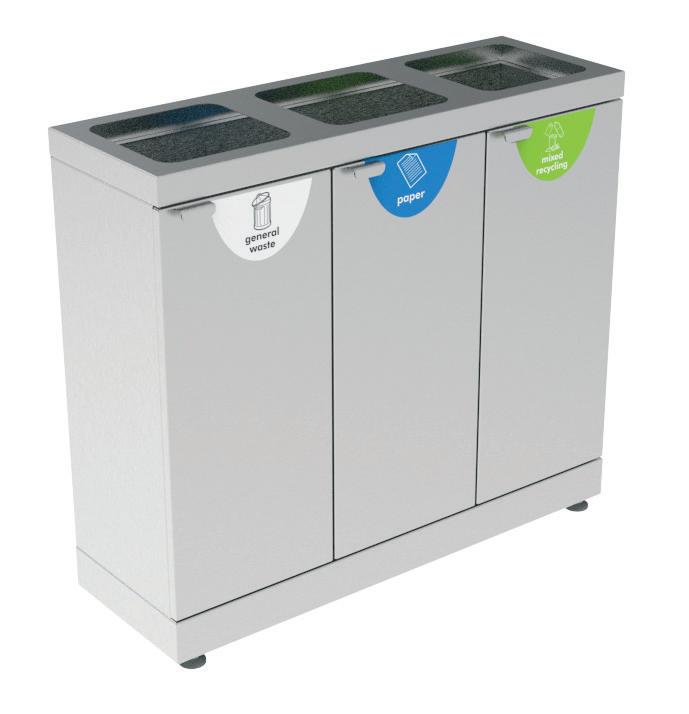
BIDVEST NOONAN LAUNCHES TASK: A CLOUD-BASED OPERATIONS PLATFORM FOR INTELLIGENCE-DRIVEN SERVICES
Bidvest Noonan, a leader in the FM sector in the UK and Ireland, announces the introduction of Task, a cutting-edge cloud-based operations platform. Developed for its 27,000-strong workforce, Task was engineered to enhance service processes, employee management, and asset tracking, transforming the way the company operates in the field.
Task will change the way service teams work, allowing them to leverage real-time data generation and analysis to provide actionable insights for continual service improvement. Its comprehensive suite of applications caters to diverse operational needs across the company, ensuring enhanced quality, accountability, and consistency in service delivery.


The platform’s capability to attach detailed instructions and guides to tasks ensures consistently high service standards, focusing on safety and professionalism. Cleaning teams can access specific instructions for impeccable results, boosting client satisfaction. Teams can access integrated Risk Assessment and Method Statements and Schedules. Security teams benefit from Task's GPS and NFC technologies, which ensure proof of presence and detailed digital audit trails, thereby o ering clients enhanced assurance. The integrated panic button is a highly-valuable safety feature, ensuring swi emergency responses for security personnel.
Task’s digital approach to operational documents plays a crucial role in supporting Bidvest Noonan’s commitment to environmental sustainability.
https://bidvestnoonan.co.uk
0203

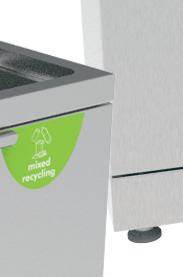
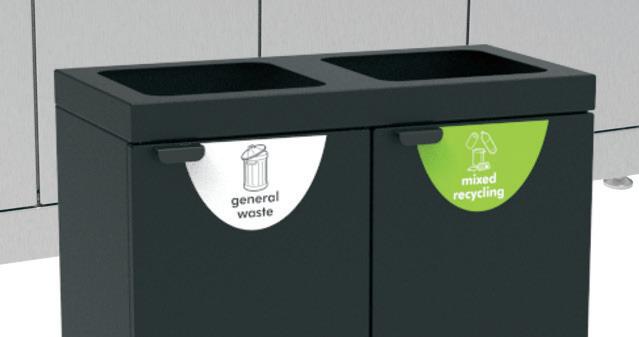
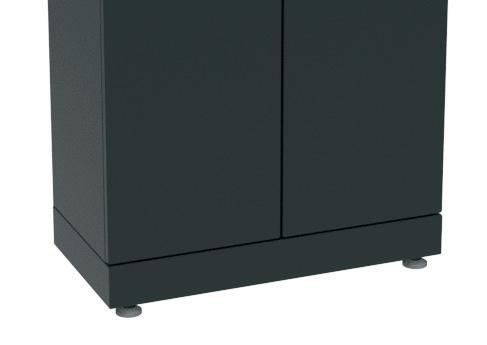
TORK PROMOTES SUSTAINABILITY AND HYGIENE AT INTERCLEAN
Sustainable products and services designed to maximise hygiene while minimising environmental impact will be among the highlights of the Tork stand at Interclean.
Taking centre stage will be Tork carbon neutral dispensers which have been nominated for an Amsterdam Innovation Award.
Essity is o setting carbon emissions from dispensers by investing in certified climate projects with ClimatePartner. A total of 27 Tork washroom dispensers for soap, toilet tissue and hand towels have now been certified as carbon neutral including the Tork SmartOne® Toilet Paper Dispenser; the Tork PeakServe® ContinuousTM Hand Towel Dispenser; the Tork Coreless Midsize toilet paper system and Tork soap dispensers.


Making their debut at Interclean will be new Tork Xpress® Compressed So Multifold Hand Towels. These come in bundles that have been compressed by up to 50 per cent to prevent the need for frequent refills.
Also new is the Tork Soap and Sanitiser Dispenser with Arm Lever for touchless dispensing, and the Tork 2 in 1 Scouring and Cleaning Cloth.
The new Tork Natural Colour range of washroom tissue products will also feature. Besides being highly sustainable, the products are also significantly so er to the touch than traditional recycled washroom tissue. All Tork Natural Colour washroom products are compatible with Tork PaperCircle® - the world’s first recycling service for paper towels. Tork will be exhibiting on stand 10.101.
www.tork.co.uk
torkcs.uk@essity.com
01582 677570
MONTH IN FM TO ADVERTISE IN MONTH IN FM PLEASE CONTACT DANNY.GRANGE@KPMMEDIA.CO.UK OR CALL 01322 476811 APRIL 2024 50
319 1750
recycle@leafieldenv.com
www.leafieldrecycle.com
01225 816541
BCIA NAMES NEW PRESIDENT


The Building Controls Industry Association (BCIA) has appointed Stacey Lucas, Commercial and Marketing Director at Sontay, as its new President.
Lucas has been working in the building controls and BEMS sector for over 20 years, starting her career at Sontay in 2001 as a Customer Service Advisor. As she has worked her way up through the ranks she has built long lasting relationships with many of Sontay’s customers and made a real impact on the industry. The knowledge and insight learned over the years has given Lucas a brilliant knowledge base and high level of technical understanding of the building controls sector which has already served her well in position as VicePresident, a role she took on in November 2022.
Lucas takes over as President from Graeme Rees who has held the role for the past two years, with Jen Vickers stepping into the role of Vice-President.



NEW CFO AT WILLMOTT DIXON
James Mackenzie has been appointed to the role of Chief Financial O icer (CFO) at independent construction and property services company, Willmott Dixon.
The appointment follows the announcement of Rick Willmott stepping into the role of Executive Chairman at the start of 2024, with previous CFO Graham Dundas succeeding him as Willmott Dixon’s Chief Executive. Mackenzie, who will also join the company’s main board, was previously CFO at Willmott Dixon’s joint venture partnership with EcoWorld London, a position he held for six years, and he’ll continue that support for the JV. Prior to this, he held senior positions at Balfour Beatty, Berkeley Group and Kier.
NHSPS APPOINTS NEW MD FOR LONDON


NHS Property Services (NHSPS) has promoted Sally Tombs to the role of Managing Director for the London region.
Taking up her new position last month, Tomb’s role includes working with, and supporting, NHSPS’ customers, in addition to ensuring that all London-based properties under NHSPS’ portfolio are safe and compliant.
Tombs joined NHSPS in 2020 as its Principal Operations Manager. She then progressed in her career to become an Estates Delivery Partner. Prior to joining NHSPS, she held positions in facilities management and property services at Telereal Trillium, Cofely UK, and Metropolitan Thames Valley Housing.
Over the past 20 years, Tombs has acquired a diverse skill set and vast experience in the property and facilities’ sectors, and latterly, the health sector. She has also developed many key relationships with NHSPS’ customers and stakeholders.




FACILITIES MANAGEMENT JOURNAL JOBS
FACILITIES MANAGEMENT JOURNAL JOBS Looking for FM candidates? • Cost-e ective recruitment advertising • Exposure to over 25,000 FM professionals • Package deals • Includes social media promotion • Advert can run until position filled –no fixed term • Listings from as little as £250 jobs.fmj.co.uk APRIL 2024 51 FMJ.CO.UK FM CAREERS - PEOPLE
WHERE ARE THE WOMEN?

Emma Thornton, Marketing Manager at FM Recruitment Experts - 300 North asks, is the underrepresentation of women in FM down to poor communication?
Women make up around 21 per cent of the FM workforce according to an IFMA survey. An IWFM survey gives a more charitable estimate for the UK sector, with a 34/66 percentage split of women to men. Regardless of the exact numbers, it is agreed that the sector is male dominated and needs more widespread female representation.
The lack of diversity in FM presents potential barriers to business growth, so companies have adopted a range of methods to address the communications challenges of articulating the benefits of a career in FM to women and adjusting recruitment strategies to increase applications.
SENIOR LEADERSHIP
A major factor in the success of equity, diversity, and inclusion (EDI) programmes is having the backing from the board and C-Suite. Many businesses have this buy-in but the message isn’t always filtering down from that level to operational managers.
“It’s really important that organisations have a very strong value proposition that is equitable and fully inclusive at its core,” says Clair Bush, Chief Marketing O icer at The Recruitment Network. “Companies should look to write and support a framework with touchpoints that include open dialogue, key
LATEST JOBS ON FMJ
CHIEF ENGINEER
Salary: £56,445 - £66,356 pa
Location: Kew Gardens - Richmond
https://bit.ly/49jIVaS
ASSET DATA MANAGER - EAST REGION
Salary: £45,000 - £50,000 per annum
Location: Norfolk (allows remote working)
https://bit.ly/3TEdfHq
GENERAL MANAGER
Salary: £35000 - £45000 per annum
Location: Bristol
https://bit.ly/3x7RI2g
messaging, and engagement with all stakeholders at every stage so that nobody can fall through the cracks.” Inclusion should integral to the day-to-day, and also to the recruitment strategy, encouraging more diverse talent into FM.
Secondarily, companies should consider whether their employer brand is appealing to women. One way to improve appeal is to establish progressive gender parity policies which show a serious intent towards rectifying the gender disparity, something many leading FM companies have.

Rachel Palmer, ESG Manager at Johnsons 1871 told us: “Businesses need to start asking themselves, their clients and suppliers how they are supporting women. Not aggressively, or judgmentally, but to start the conversation. If you haven’t got as many women as men in your business, how do you encourage more women to apply? Because if they’re not applying, you can’t hire them.”
TARGETED RECRUITMENT CAMPAIGNS
FM organisations can do more to promote themselves to potential workforces outside of the sector. Using targeted recruitment campaigns, companies can engage publicly with a wider audience to whom they can advertise their services, employer brand and value proposition.
This can be done through publicising their benefits programmes. Benefits that best support women include flexible working arrangements, providing leave to support family and caring responsibilities, healthcare, and financial benefits, all of which help everyone thrive at work.
SCHOOL ADVOCACY
Given that FM is male-dominated, women can be fantastic vocal advocates for FM in schools and colleges, encouraging girls into FM career paths. This approach gives young people the chance
to learn about the sector from women who can demonstrate the diversity of roles on o er. Other approaches include targeted, in-house educational programmes such as Equans’ Girls Believe Academy, an award-winning STEM outreach programme giving educational opportunities to girls in technology and engineering.
Research indicates that exposure to successful women in leadership positions can significantly influence career choices. “Speaking to just one inspiring role model, in a career that you may not otherwise know existed, can completely alter and fast track a young person’s career in a positive way,” says Tamsin Dewhurst, CEO & Founder at Uptree. “We need more professional women exploring their careers with young people in schools, especially those in STEM careers.”
UNCONSCIOUS BIAS
Gender stereotyping will have played a part in women not seeing themselves in FM careers, so tackling unconscious bias in the recruitment and promotion processes is imperative to any business serious about achieving gender parity. FM is a sector where taking career breaks, sidestepping into di erent roles, or moving contracts can be easier than in other markets and facilitating this can really help working women.
O ering mentoring opportunities allows women to provide education and career guidance to other employees. “We have a handful of female employees who have been with Johnsons a long time – since the business was much smaller, and they have o ered to become mentors to other women in the industry,” says Palmer. “It’s helped open the conversation for these women who are newer to FM to ask questions.”
As Shahid Bashir, Head of Diversity, Equity & Inclusion at Equans UK & Ireland outlines: “Achieving gender parity in FM organisations requires a holistic approach to enable female employees to overcome barriers at key stages of the talent journey, including both structural and behavioural challenges, whilst raising awareness for all employees on how to shape an inclusive culture. These interventions and nudges must be backed by senior leadership support and be accountable.”
Fundamentally, a person’s ability to succeed professionally is unrelated to their gender. It is about their aptitude, insight, and skills, and employers providing equitable opportunities for success for all employees.
FACILITIES MANAGEMENT JOURNAL JOBS
jobs.fmj.co.uk Over 250 jobs live on site FM CAREERS - RECRUITMENT APRIL 2024 52
UPSKILLING THE UNEMPLOYED

Amey’s People Director Stephanie Johnson describes a raft of recruitment and training strategies that aim to bring back the long term unemployed to the workforce

The UK workforce has been changing dramatically over the last few years as a result of postBrexit changes to immigration and the impact of the COVID pandemic in increasing the number of those with long-term illnesses.
The latest figures show the greatest contributor to economic inactivity is by those su ering from long-term sickness, rising from around two million at the start of 2019 to two and a half million by January 2023.
Understanding these trends and putting in place strategies to help combat the realities of this workforce change is critical for businesses who are highly dependent on having a trained, committed and flexible workforce available.
What is clear is that there is no single, simply solution to the on-going skills challenge; nor is the problem to be solved by the public or private sector alone.
Our experience has shown us that
we must work on multiple fronts with multiple initiatives to target a variety of demographics and specific life situations so as to equip people for life changing careers.
FOCUSSING ON SOCIAL MOBILITY
While the UK’s economic inactivity total has been driven by an increase in those with long term illness, a number of other key groups have been rising.
The UK unemployment rate sits at 4.2 per cent, up on pre-pandemic levels. It also shows that our overall employment rate of those between 16 and 64 years old currently sits at just 75.7 per cent.
This may include former students seeking work, those returning to work a er a break or looking a er family and those who feel actively discouraged from work or believe that no jobs are available to them.
Typically, many of these people are in less socially mobile communities, and for whom unemployment has o en
BUILDING SKILLS
Many facilities management roles require specialist skills. But they also usually require the kind of confidence and life experience brought by older members of the workforce.
Alongside youth focused activities, we have identified a ra of initiatives targeted at upskilling key older groups that might have been, or are at risk of falling out of the working population.
This starts by helping individuals who have taken an extended career break, o en due to reasons such as caregiving responsibilities, illness, or other personal reasons, back into work. Alongside this, as signatories to the Age Friendly Employer pledge, we:
turned to unemployability.
We have been targeting these communities via a number of di erent programmes and partnerships with government and other organisations to demonstrate the very real opportunities, not just to work, but to build new and fulfilling careers.
These programmes include:
Sector-Based Work Academy Programme (SWAPS): A government backed partnership programme to give job seekers the chance to learn new skills, gain work experience and help individuals to build their confidence and job prospects. A recent pilot in Amey’s Bradford schools project, resulted in two permanent job opportunities o ered and a further four interviews booked.
People Plus: This organisation provides a range of employment and skills services, where as part of this partnership, we support workshops and provide training courses to assist individuals to build confidence in their interview and job seeking skills. The most recent cohort saw 12 candidates put forward for interviews on our Glasgow schools’ contract.
Journey to Work (JtW) initiative: Candidates attend employability workshops covering CV and interview skills and are given the opportunity to apply and be interviewed for jobs on the day. Amey and its partners also o er work experience and to date, some 84 people have found jobs a er attending these events.
Recognise the importance and value of older workers.
Are committed to improving work for people in their 50s and 60s (and beyond).
Are prepared to take action to help them flourish in a multigenerational workforce.
Working with partners such as Maximus and their Restart programme and STEM Returners, many highly skilled workers have been returned to permanent employment.
As signatories to the Armed Forces Covenant and achieving Gold in the Defence Employer Recognition Scheme, our armed forces programme is designed to attract, onboard, and retain veterans, spouses, reservists, and cadets.
The goal is to leverage their skills, knowledge, and leadership abilities and o er support, work placements, mentoring and role matching to bring them into a new civilian world of work. In 2023, working with partners such as BuildForces and the Forces Transition Group, Amey hired 66 individuals from the armed forces community.
Similarly, we work with serving o enders and prison leavers providing them with skills and employment opportunities. This is run in partnership with Inside Job and New Futures Network, who promote our employment opportunities by helping candidates get into work and reduce reo ending.
We invest in these initiatives because we and our customers recognise the value of encouraging a diverse workforce, that tackles inequality and that supports all individuals in the workplace.
FM CAREERS - TRAINING APRIL 2024 53 FACILITIES MANAGEMENT JOURNAL JOBS


The Tork Office Hygiene Package
67% of employees say that they are more likely to complain about a washroom than any other aspect of their office.* Cut complaints by ensuring that cleaning and washroom maintenance are run well and efficiently with the Tork Office Hygiene Package.™ tork.co.uk/officehygiene
*June 2022 Behaviourally – Qualitative and quantitative office segment research with 600+ respondents in North America and Europe. Tork, an Essity brand.
Take complaints off your to-do list Visit us at Interclean 2024! 14 – 17 May, stand 10.101

























































































































































































































































































































































































































